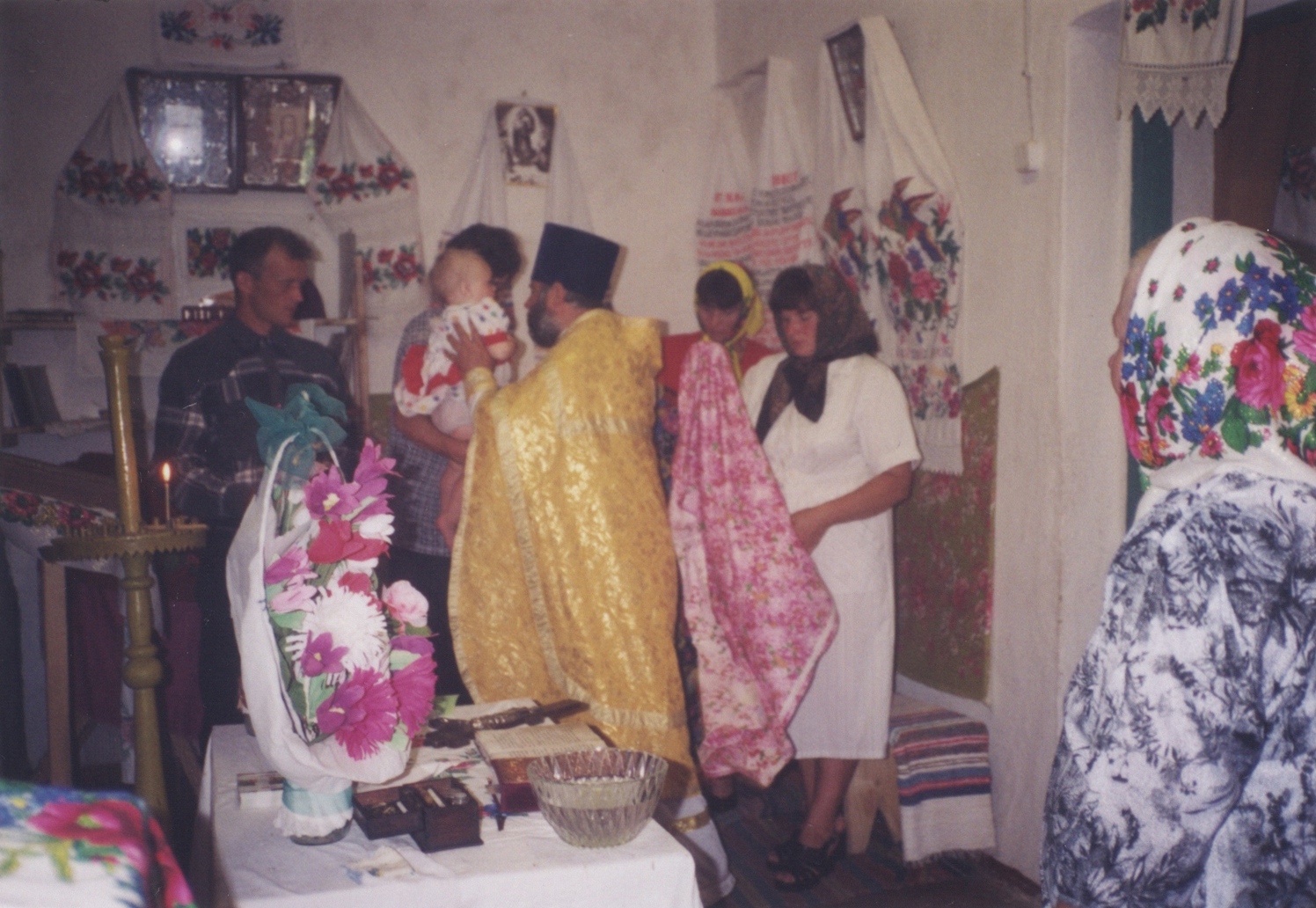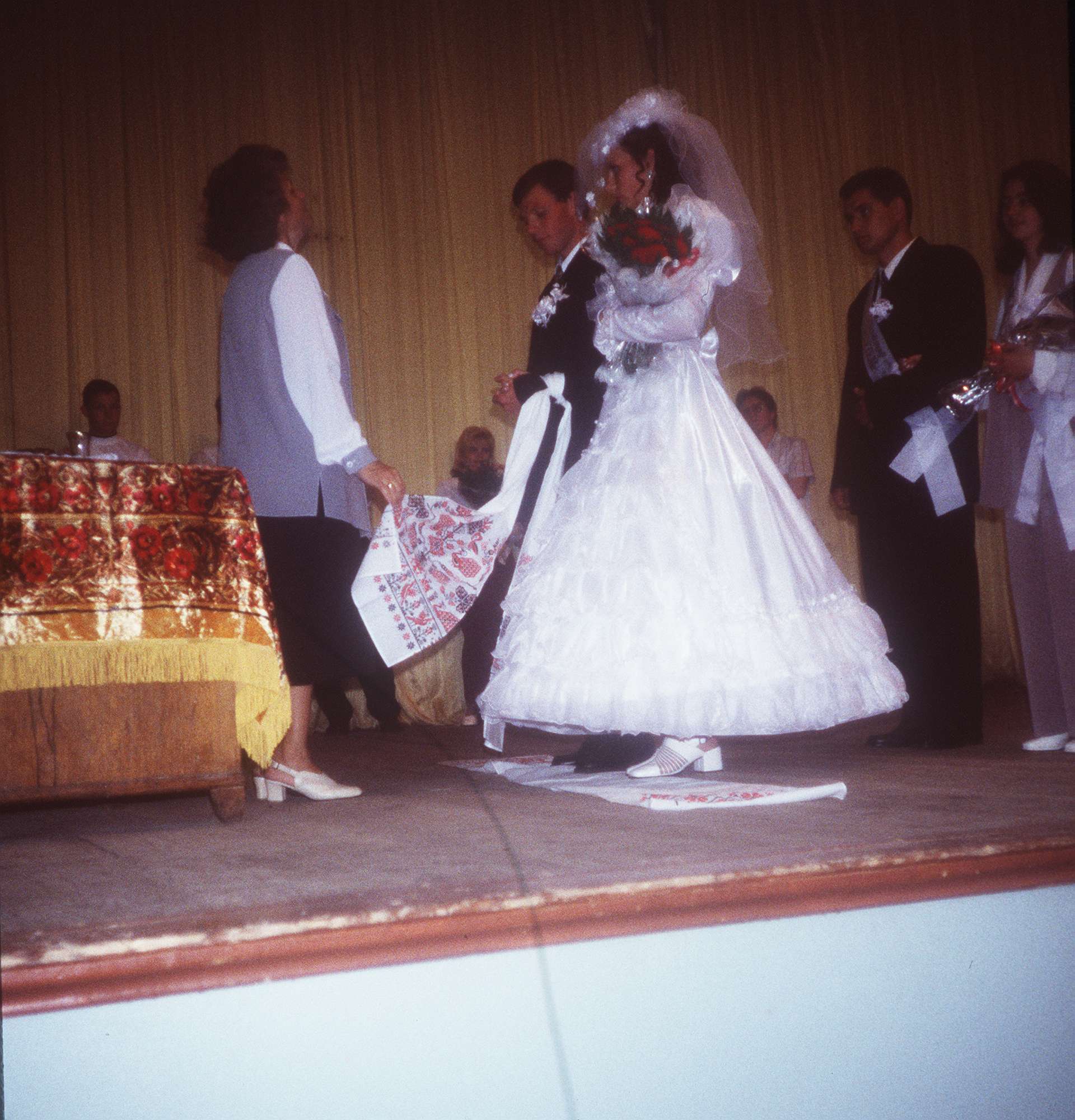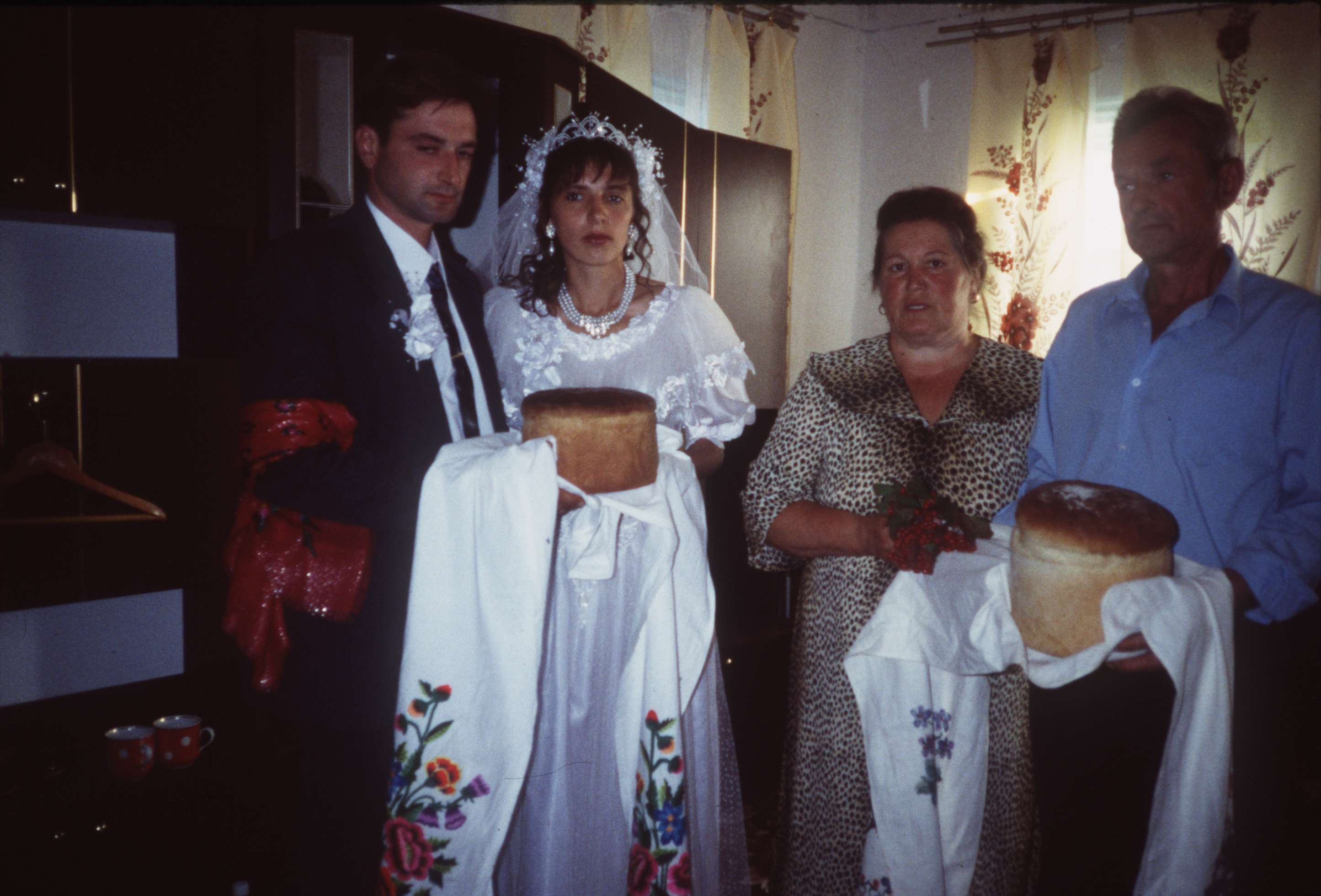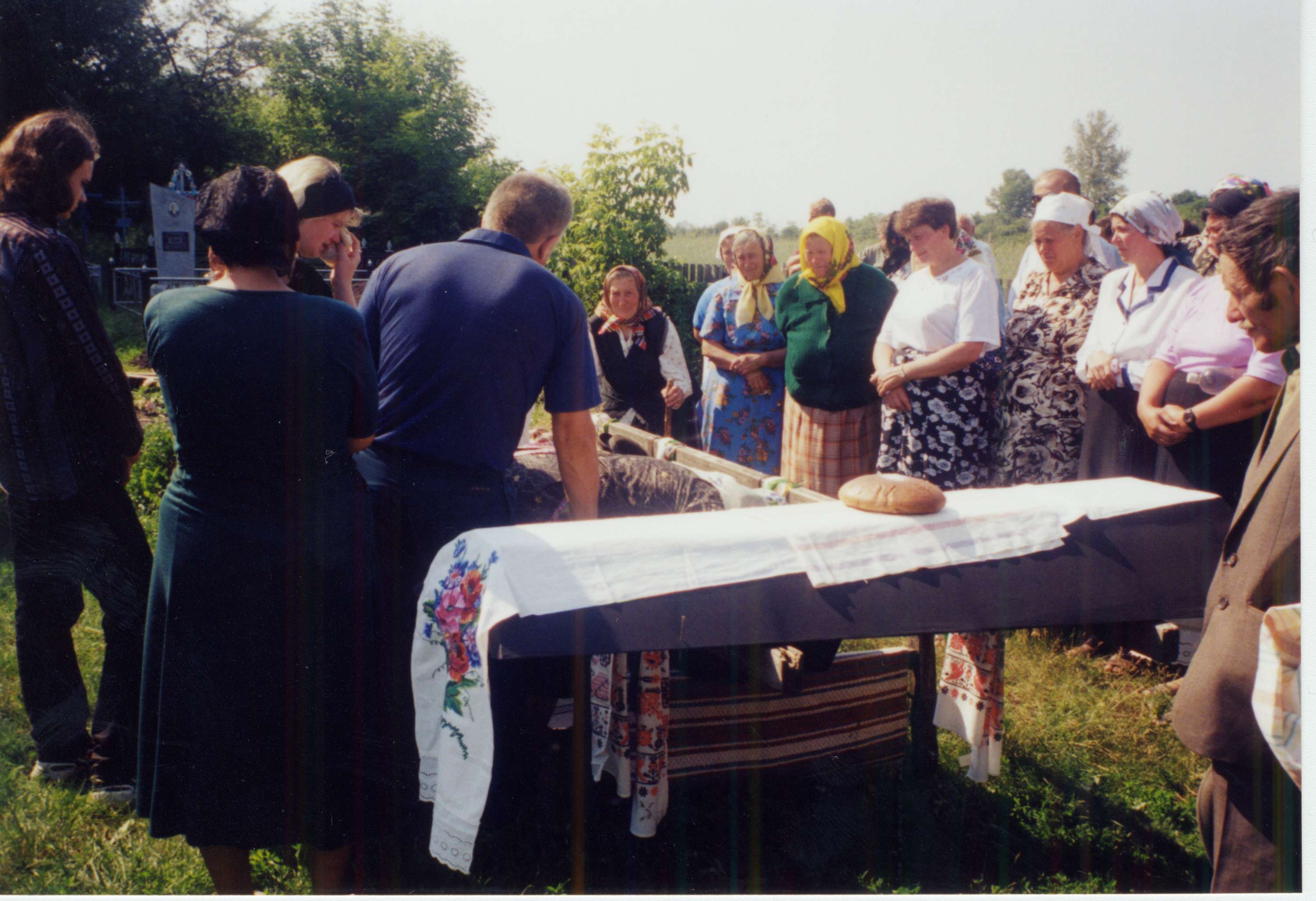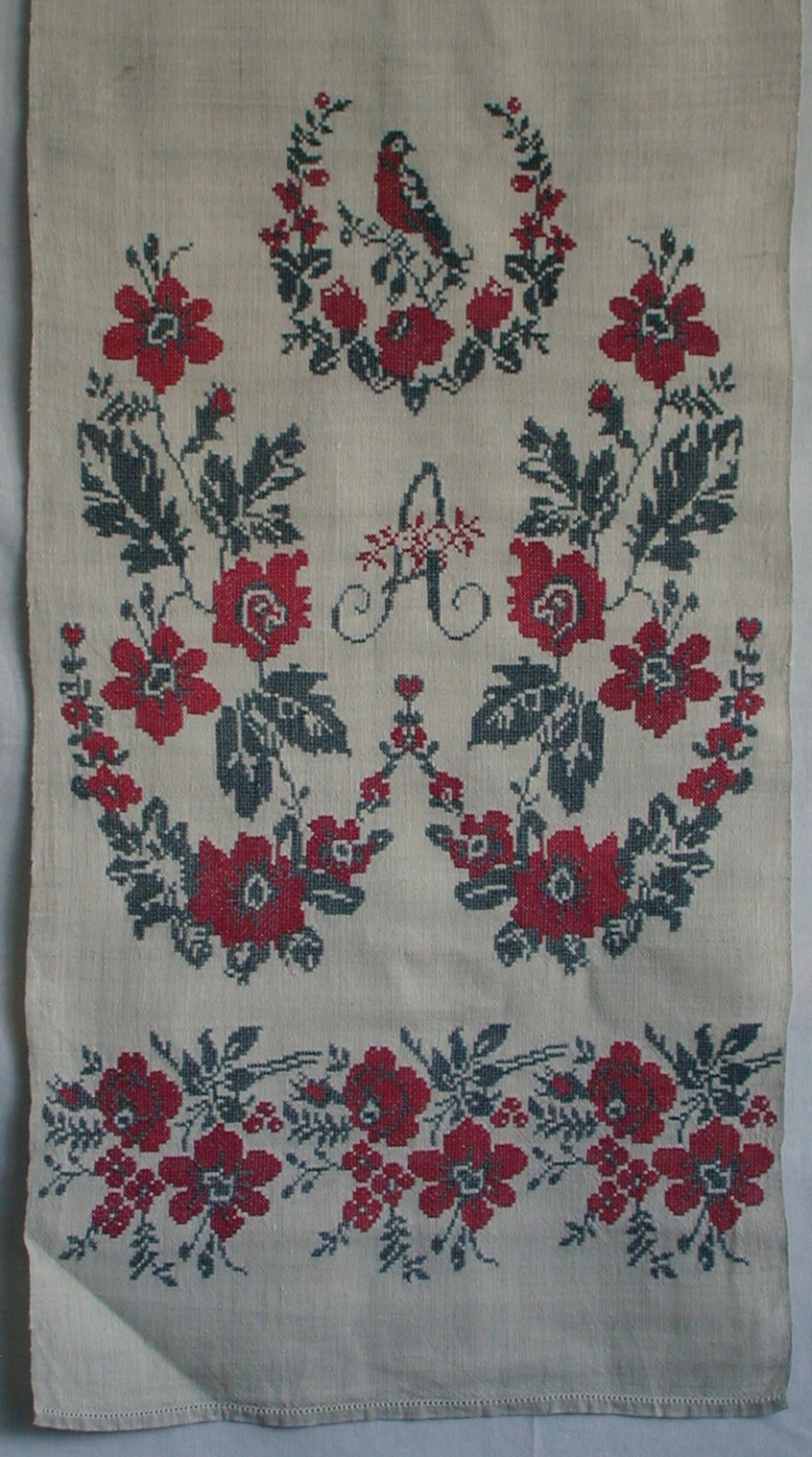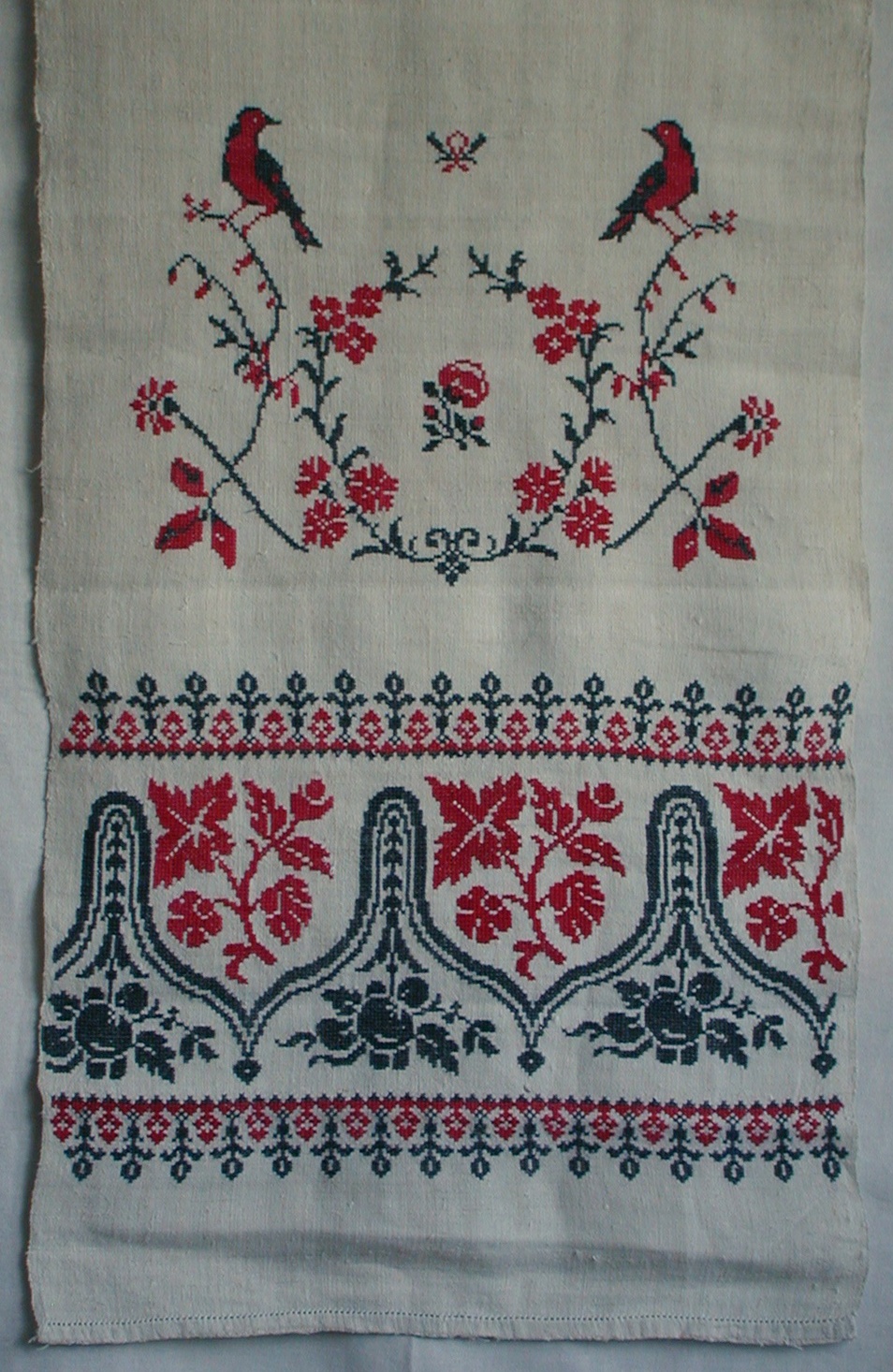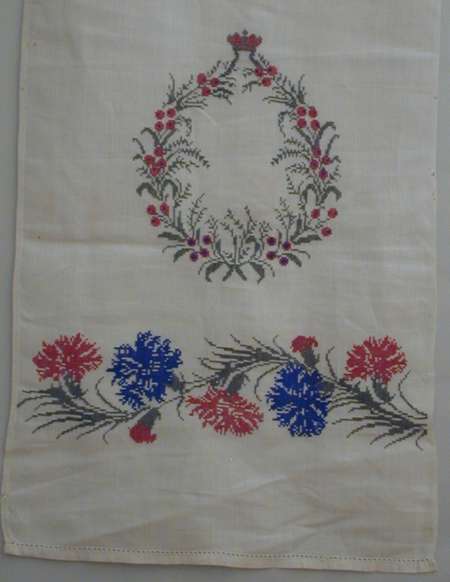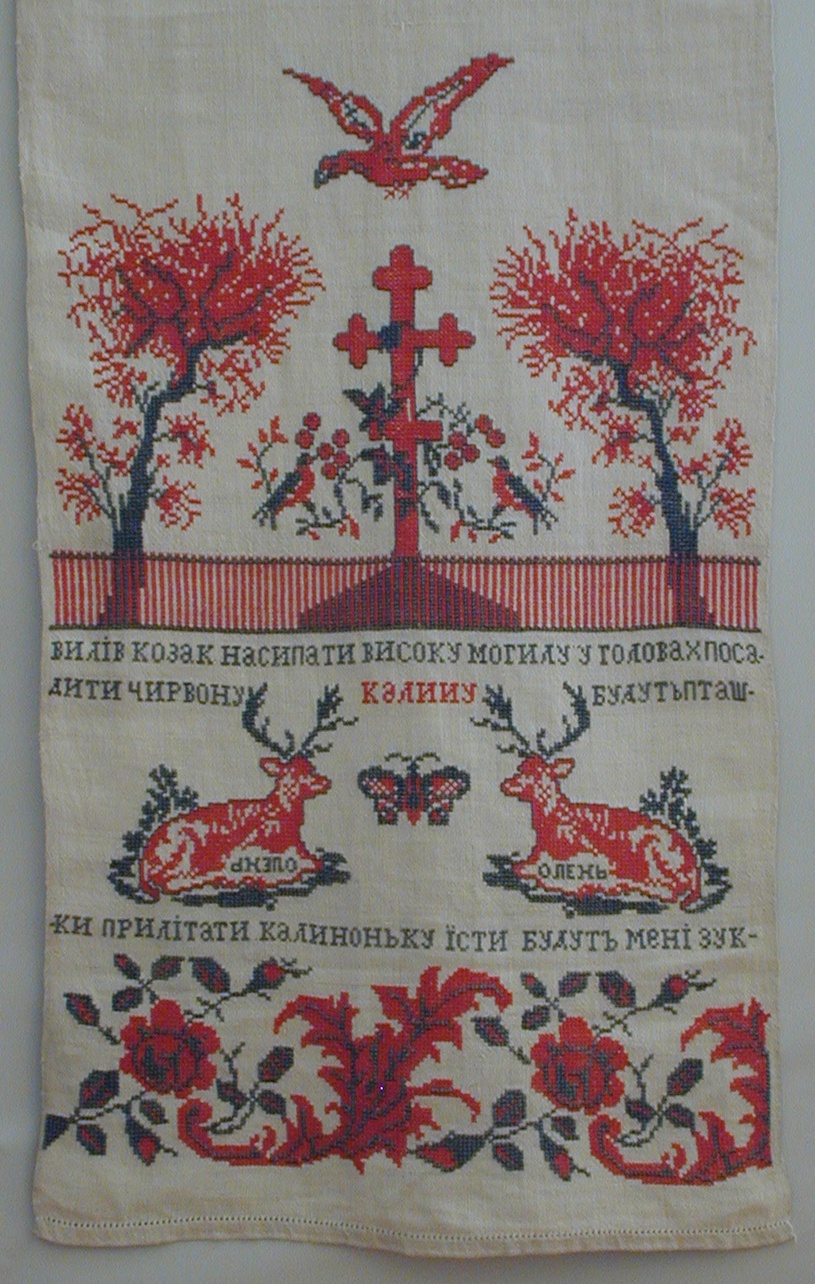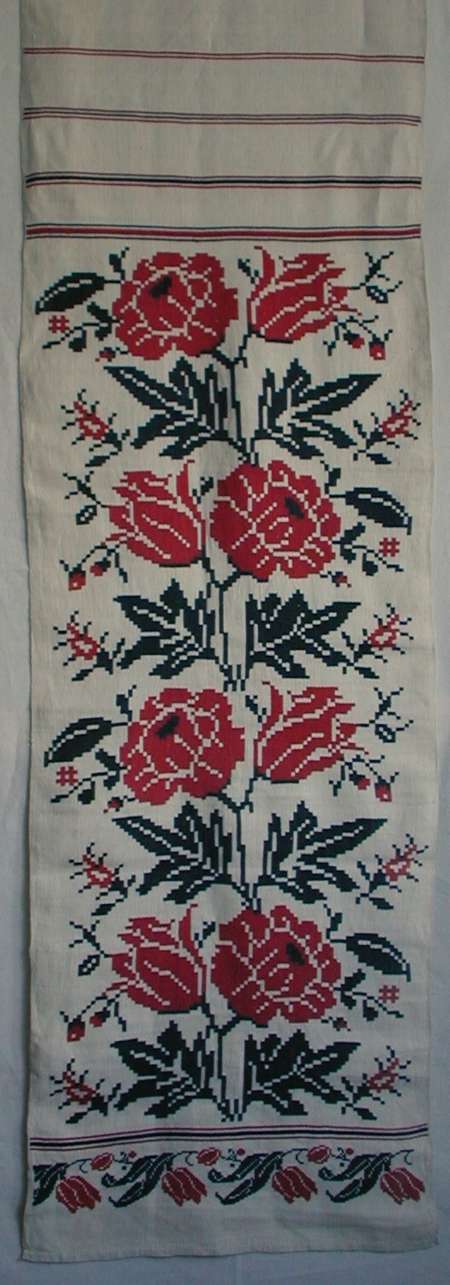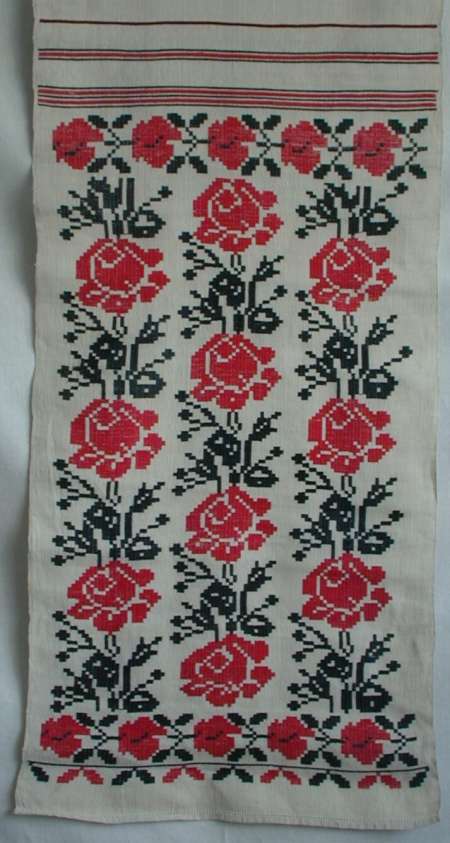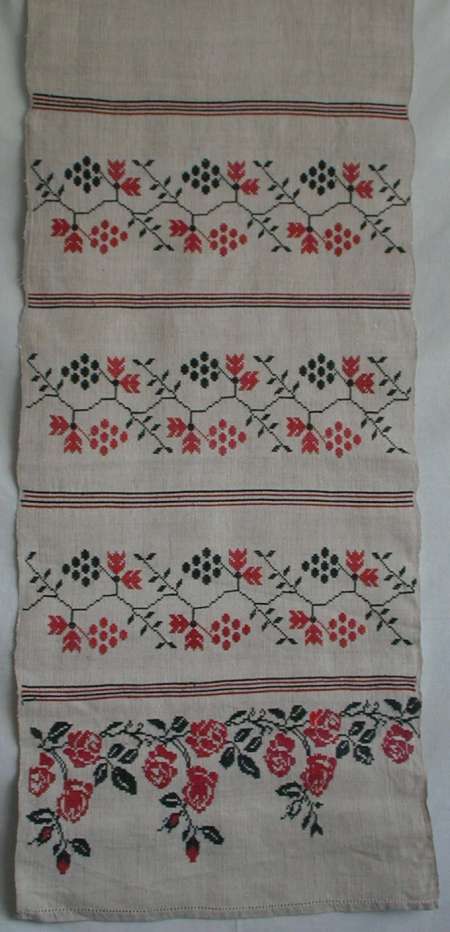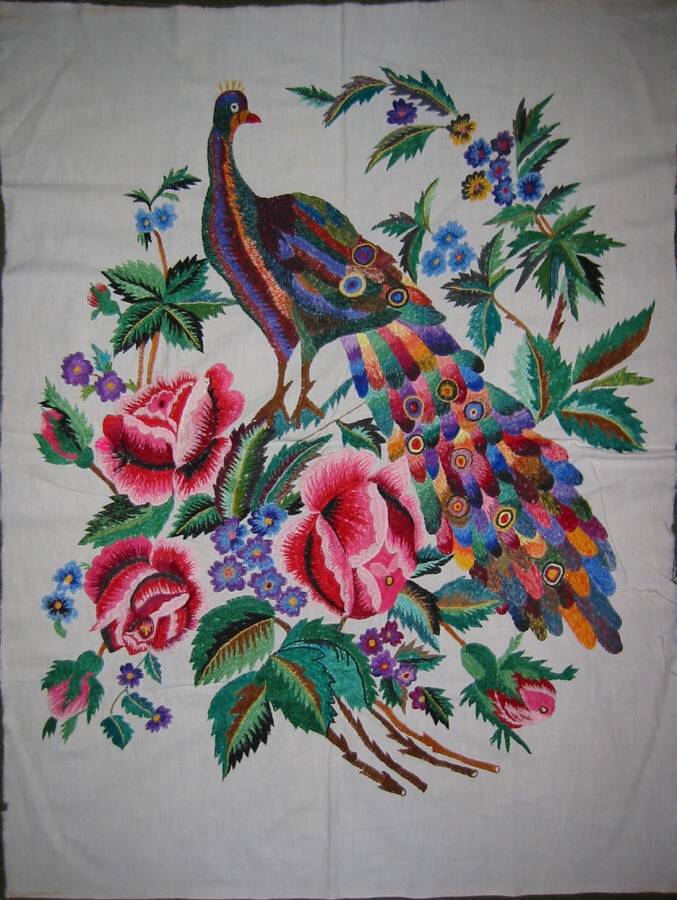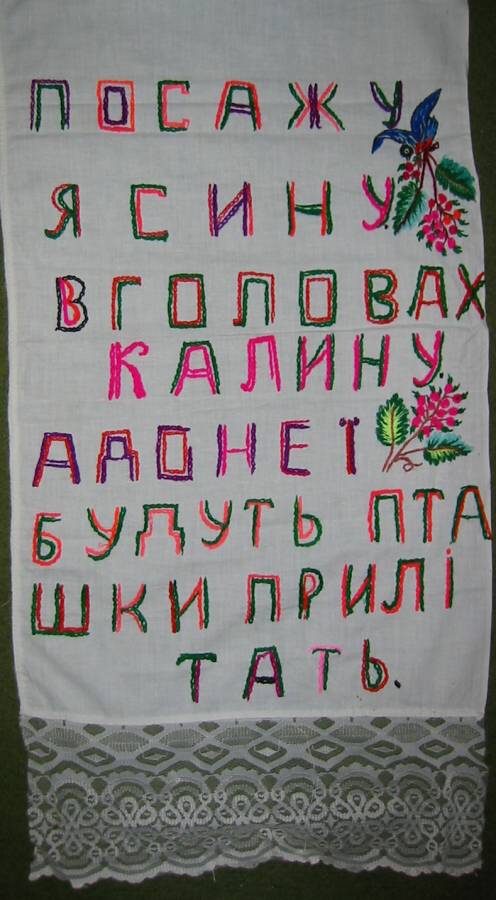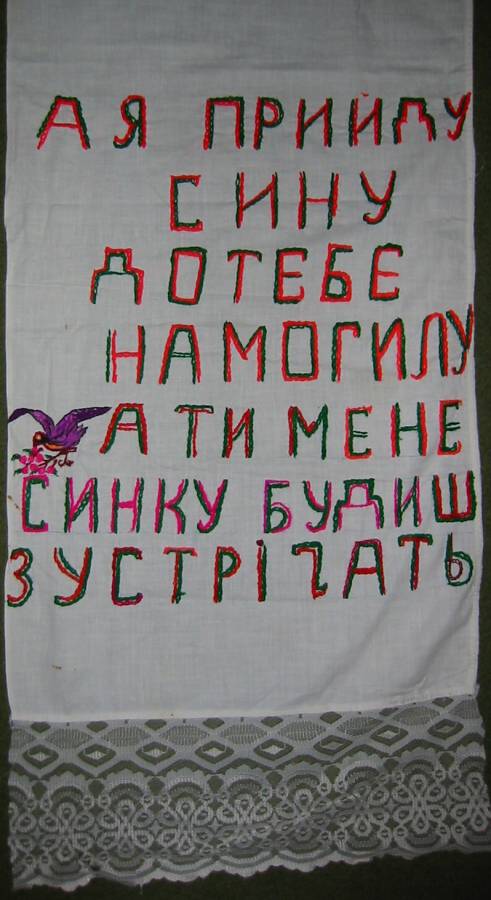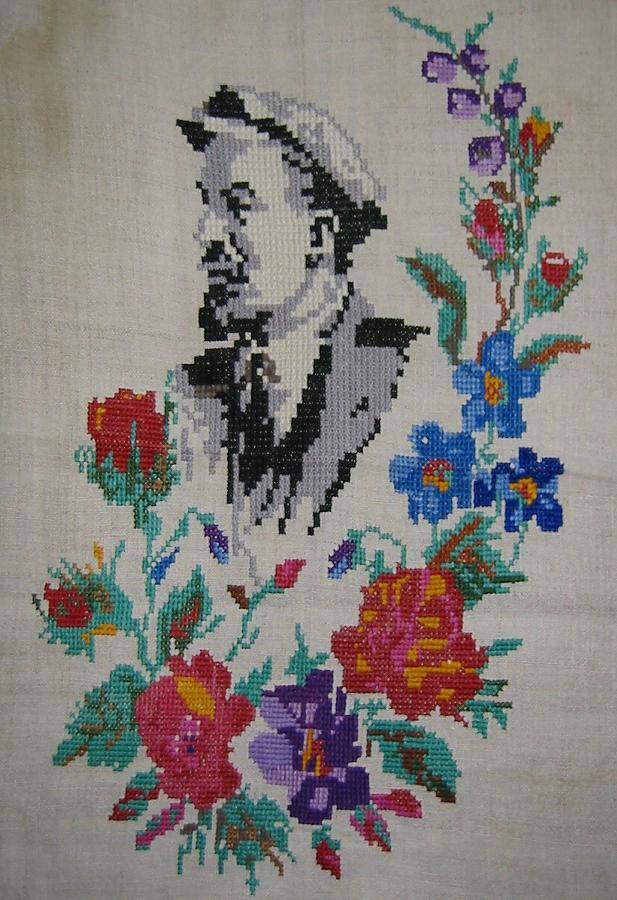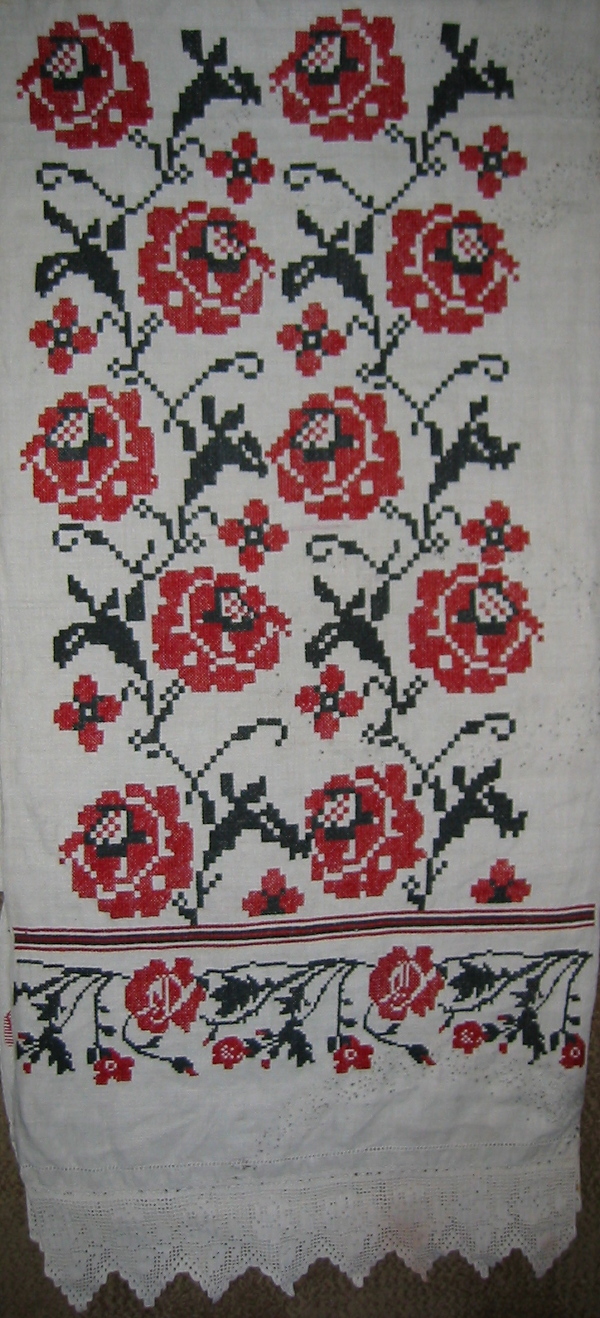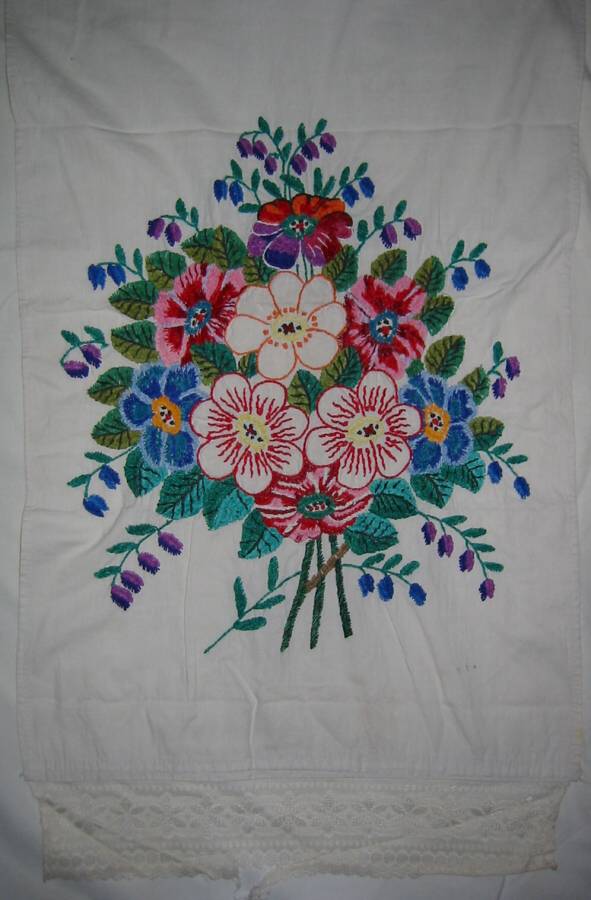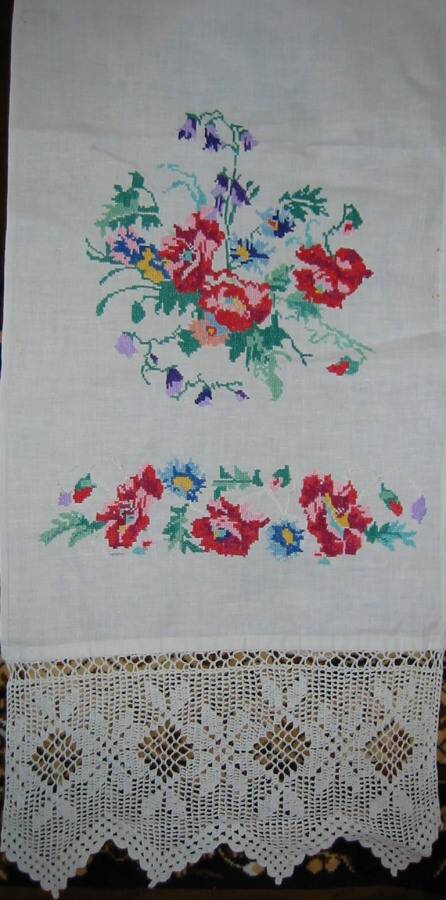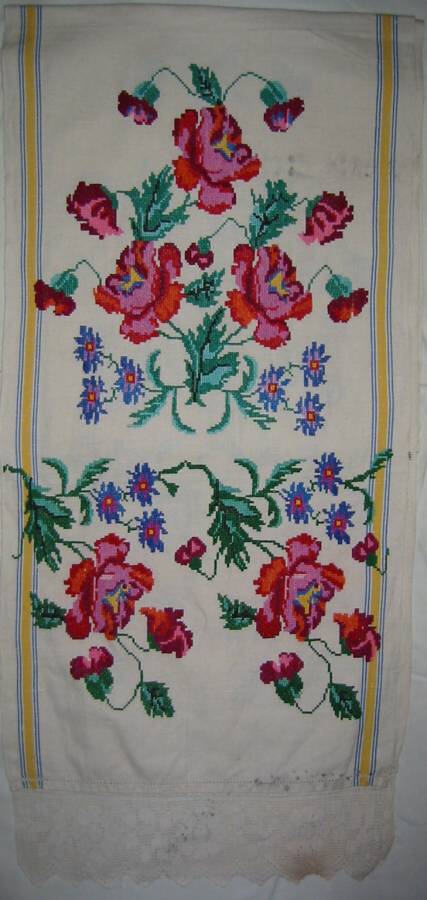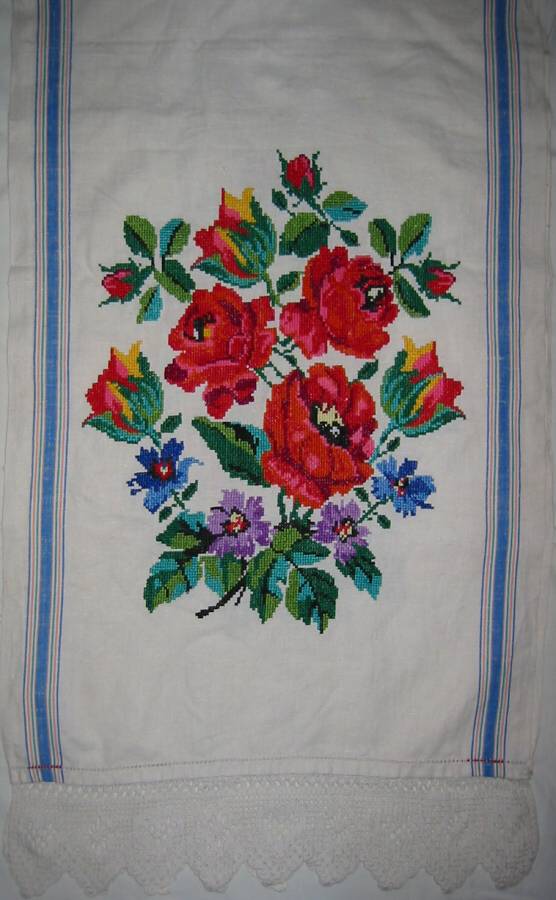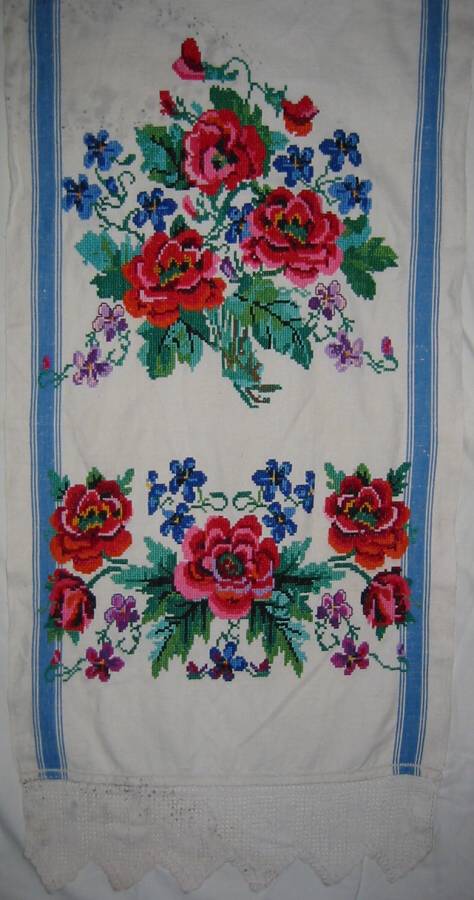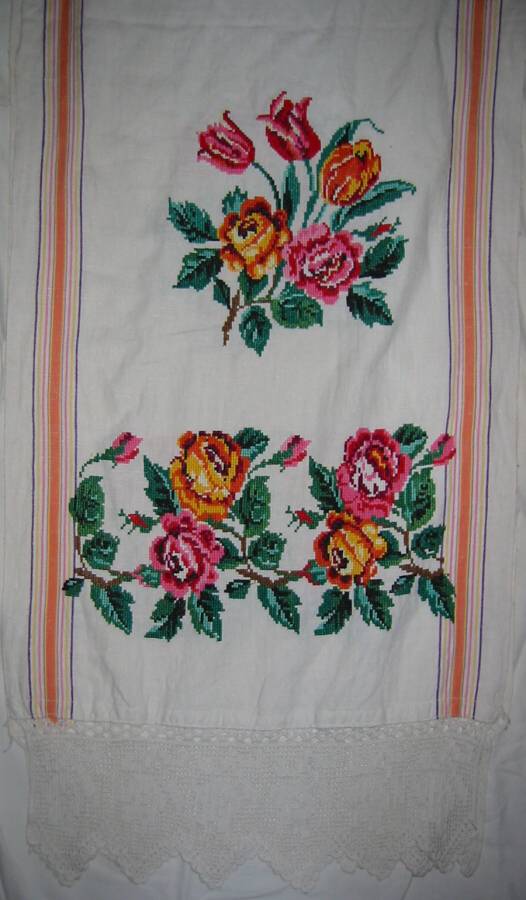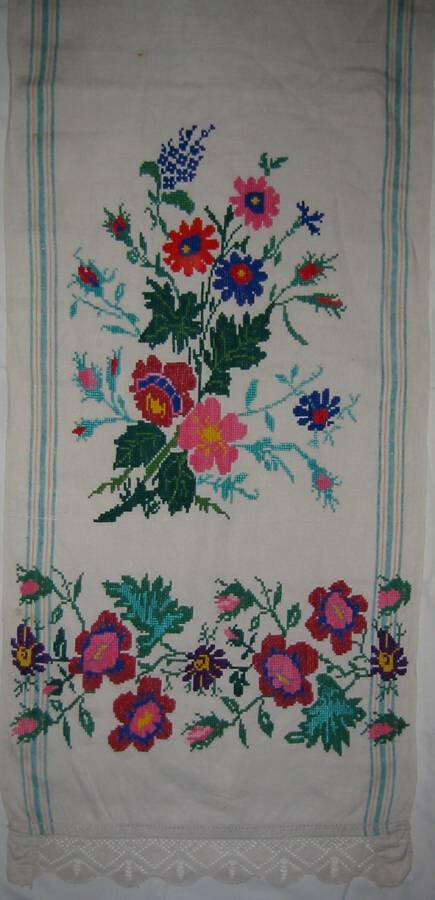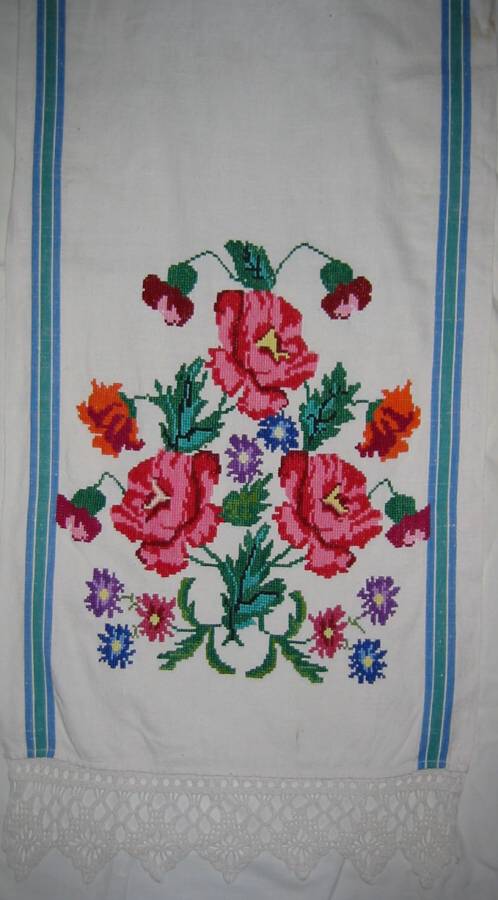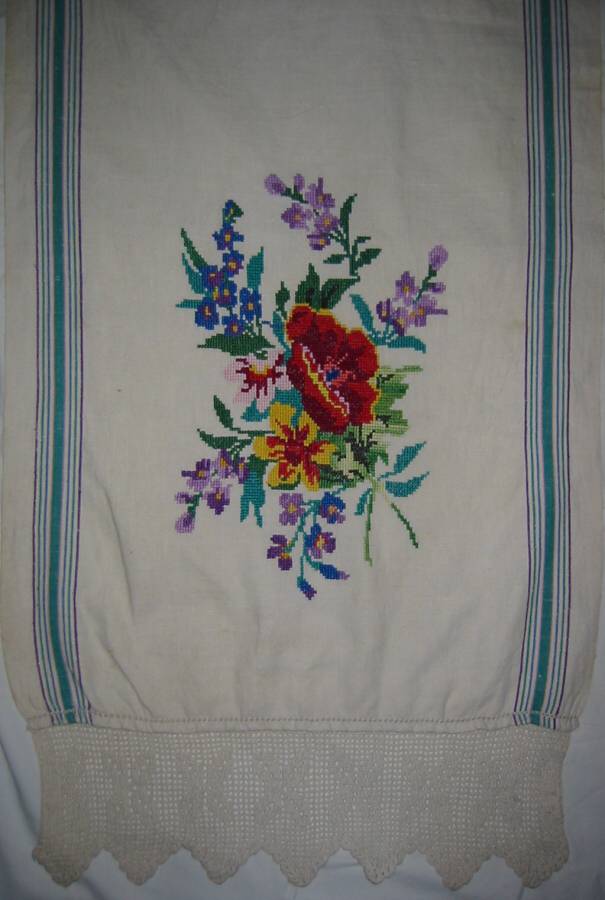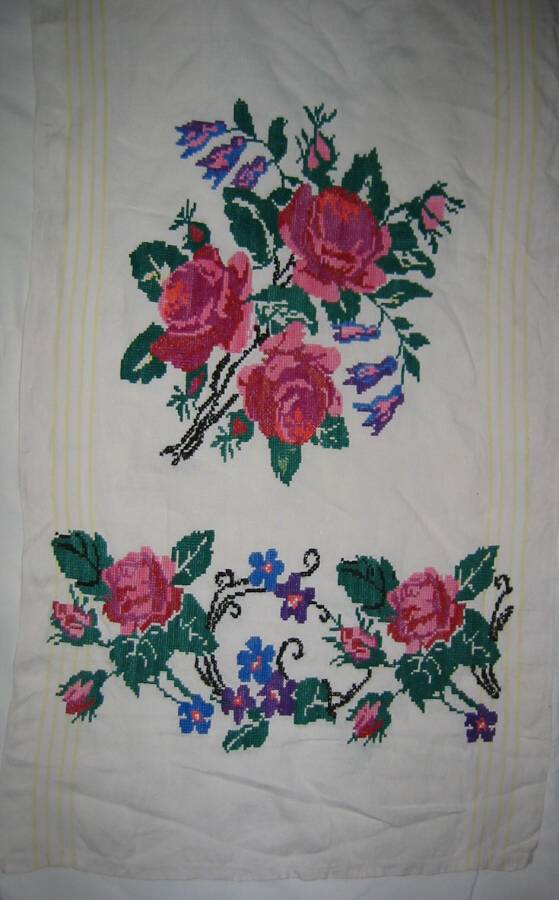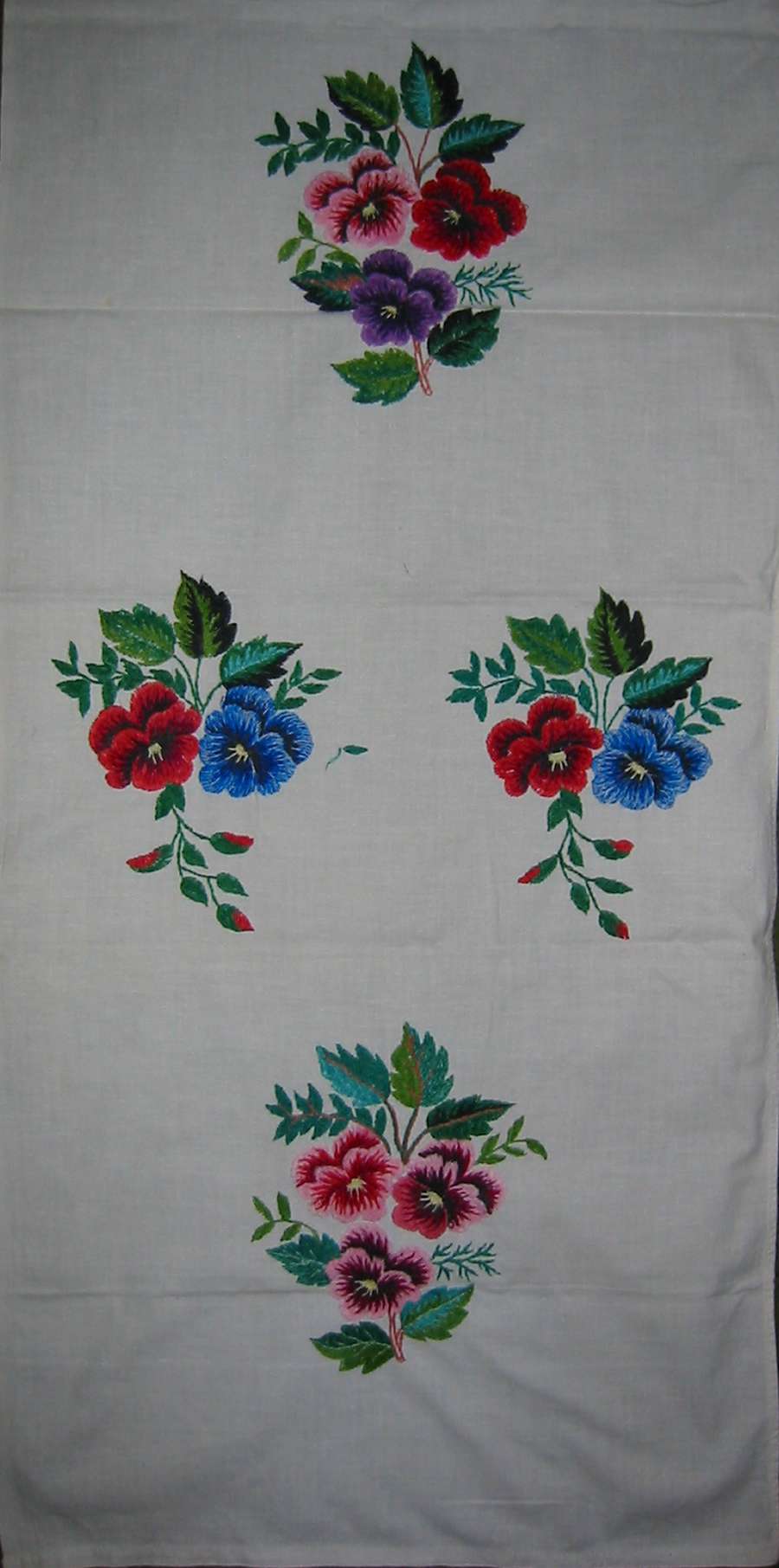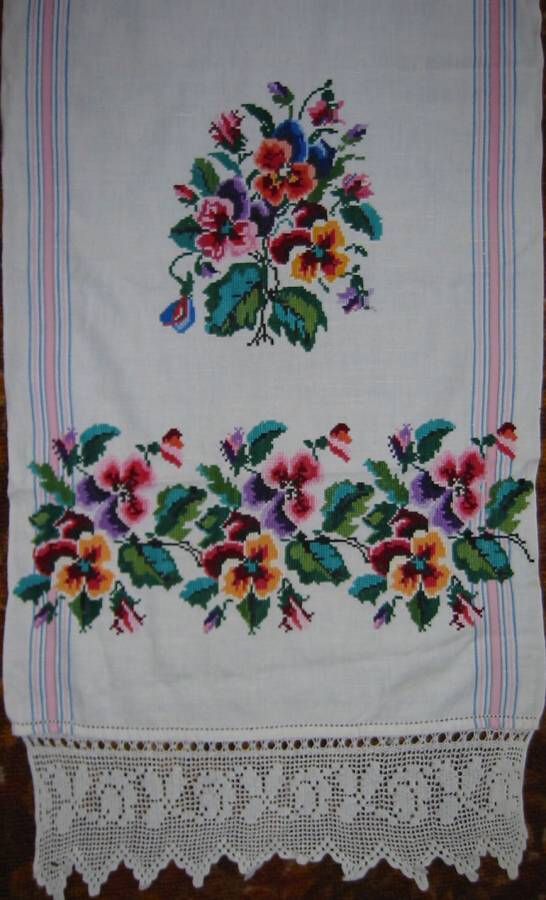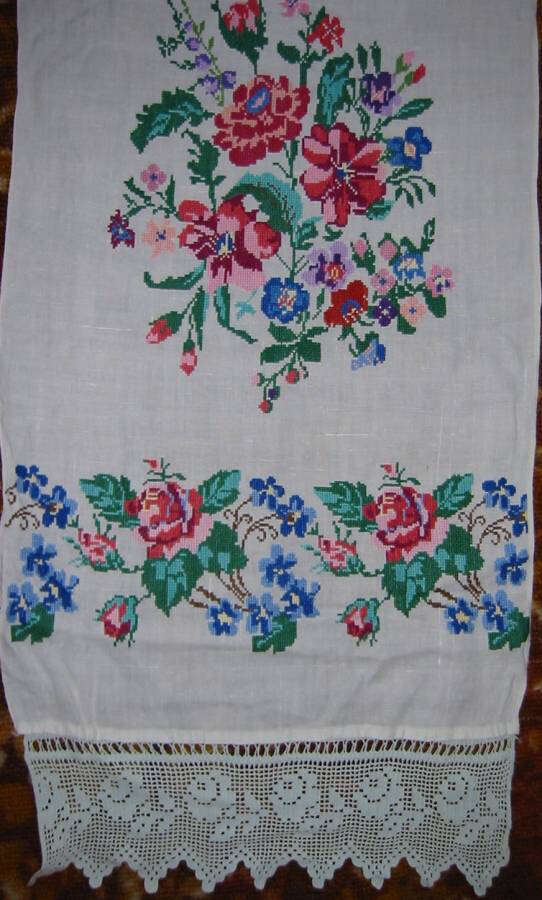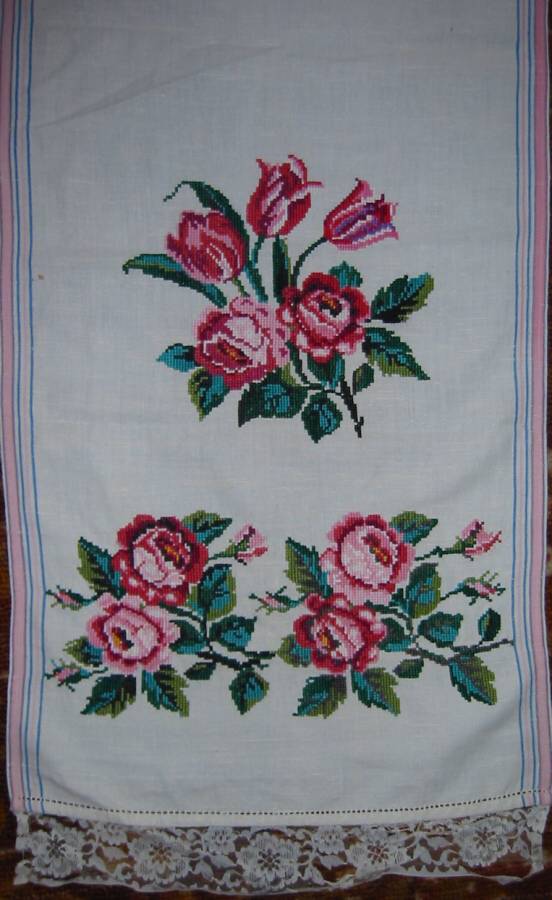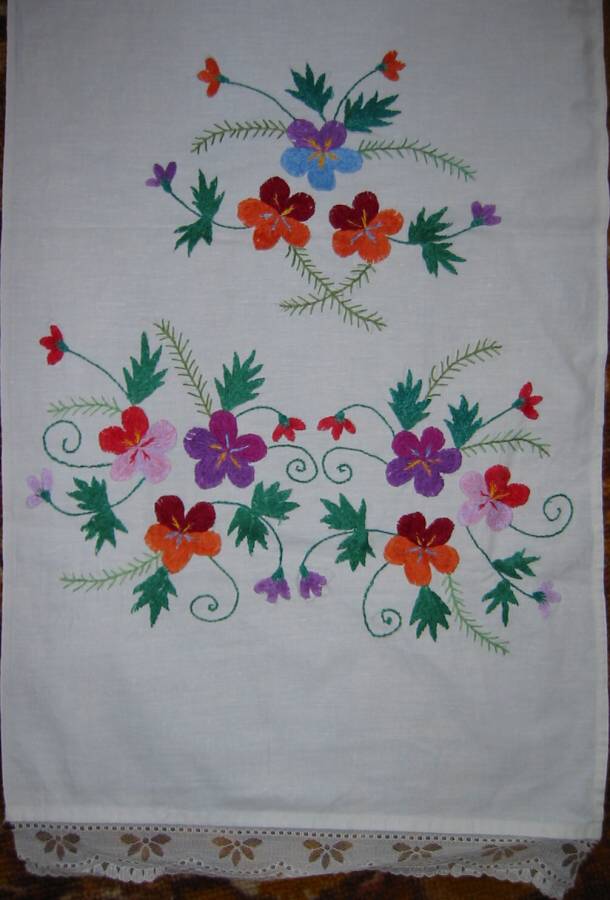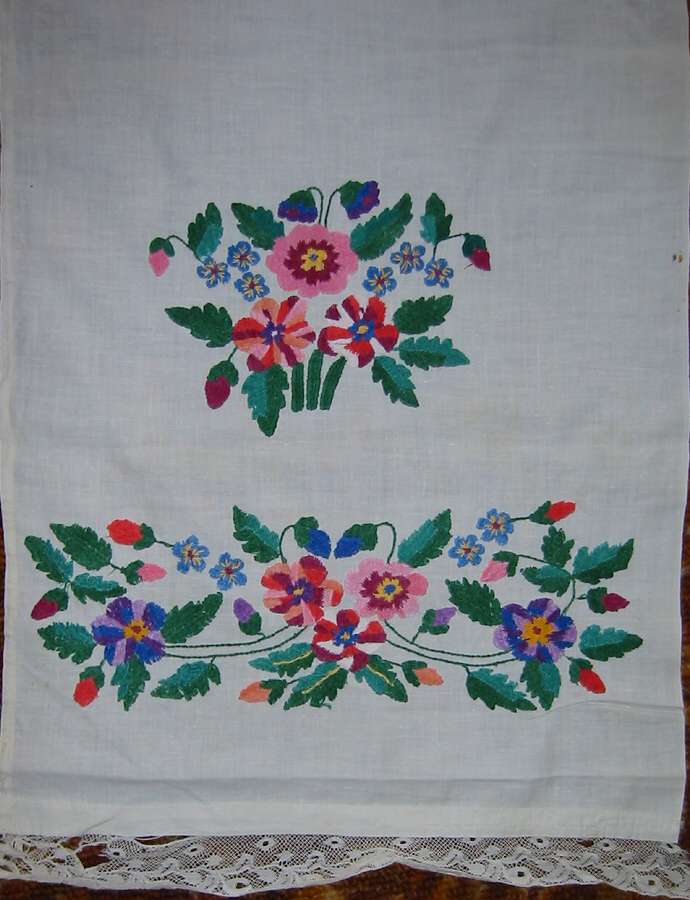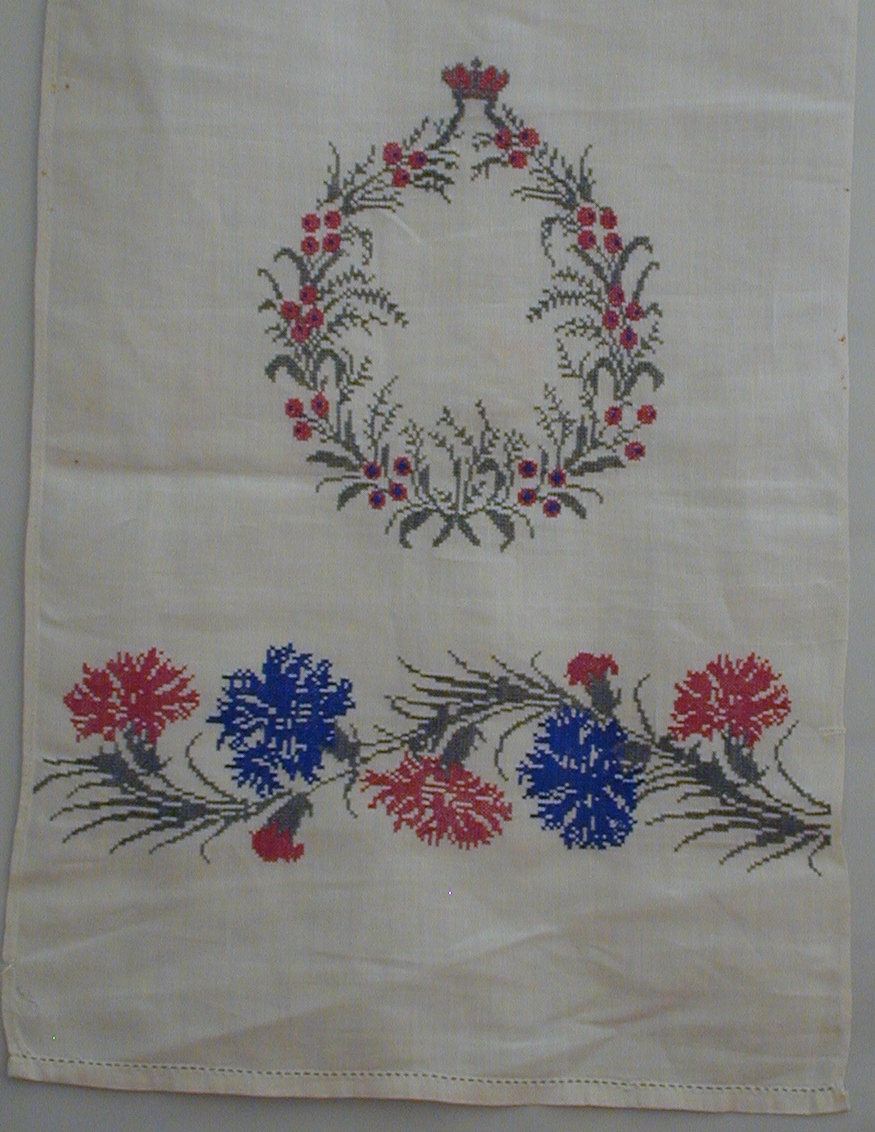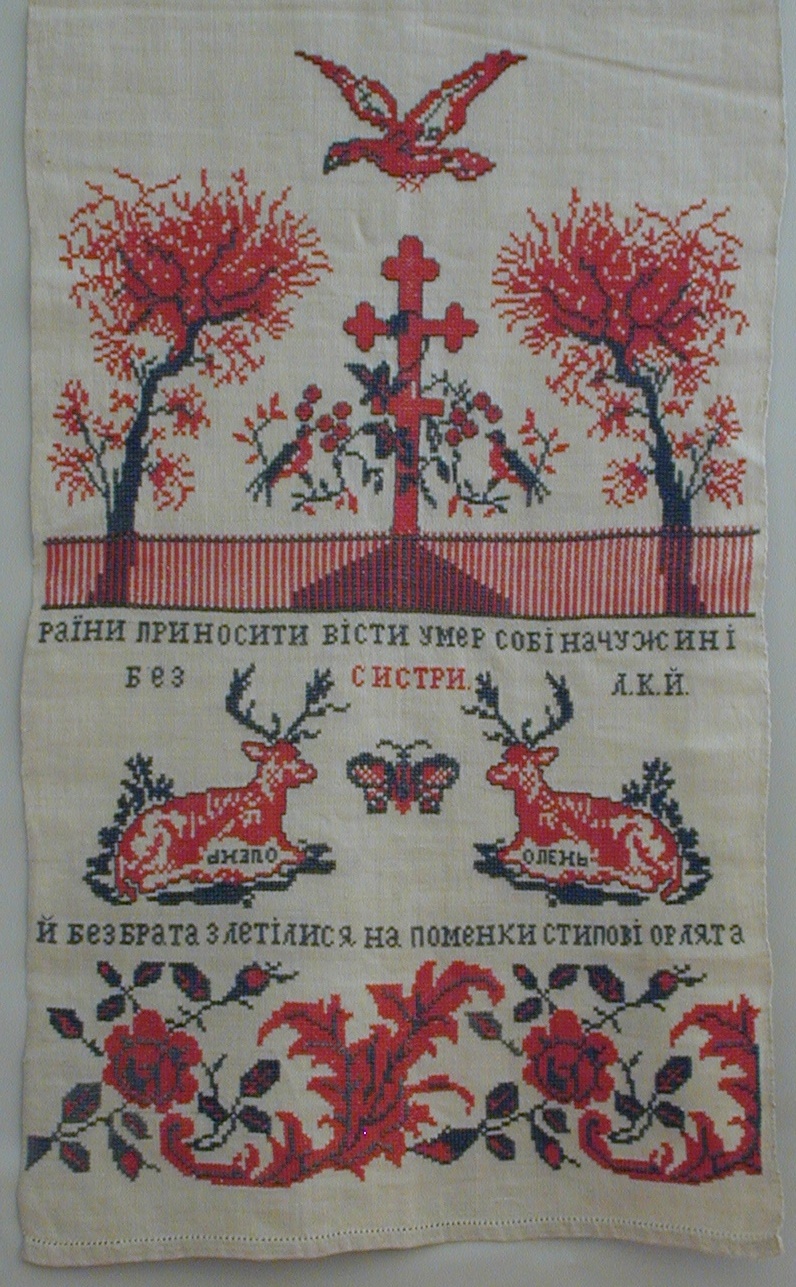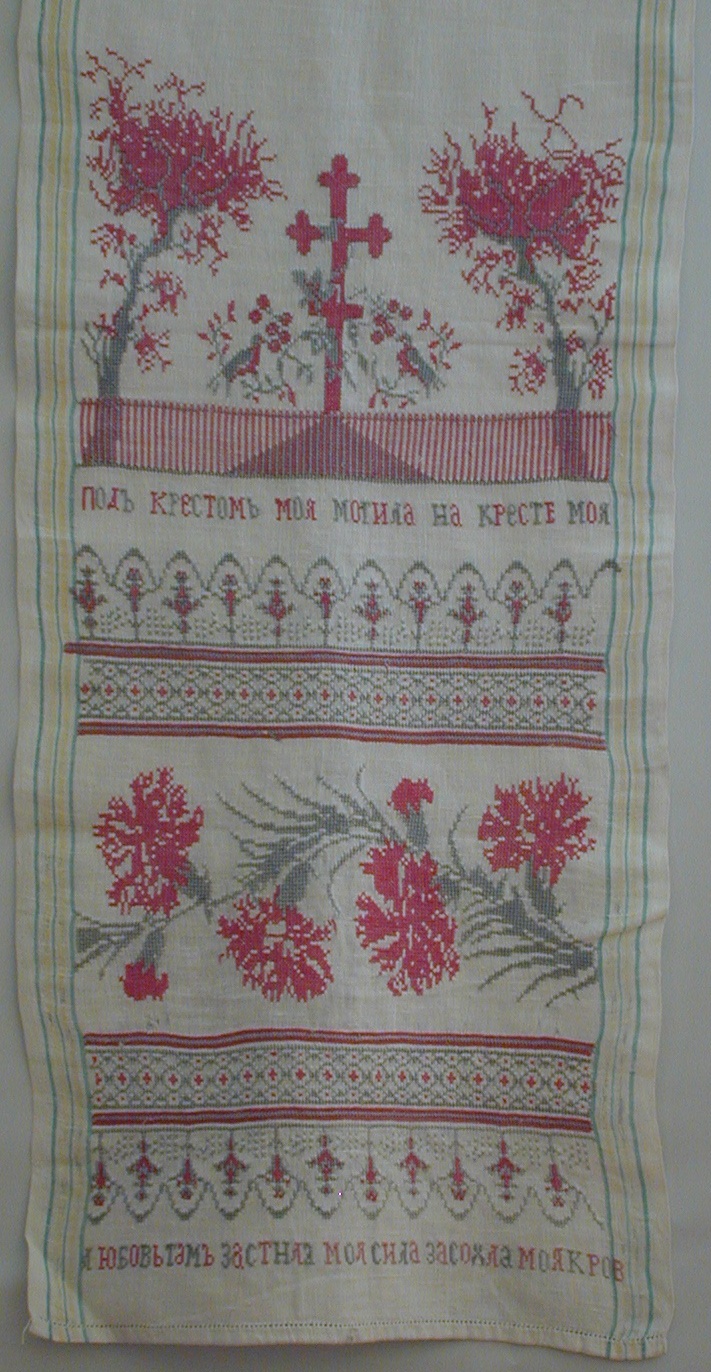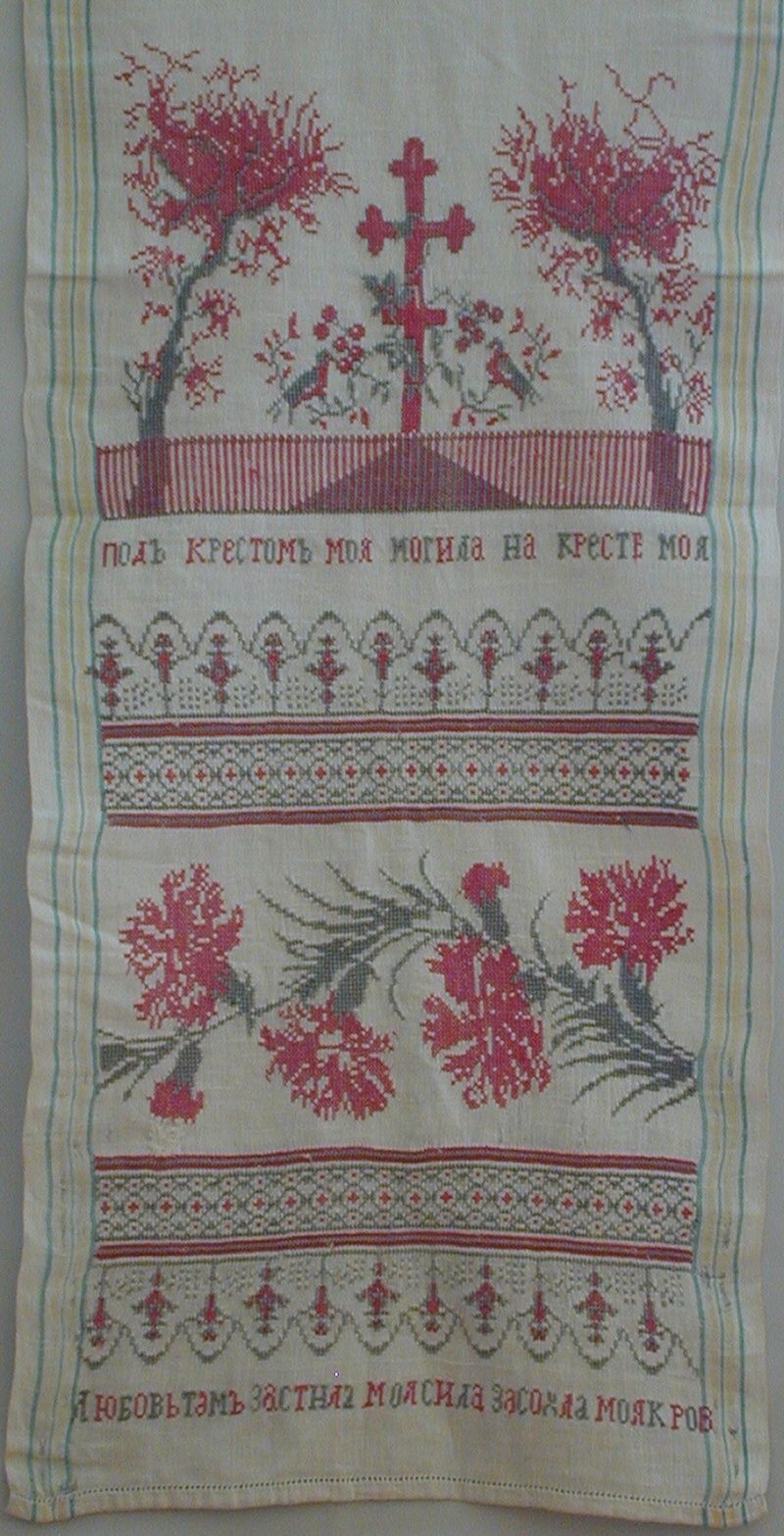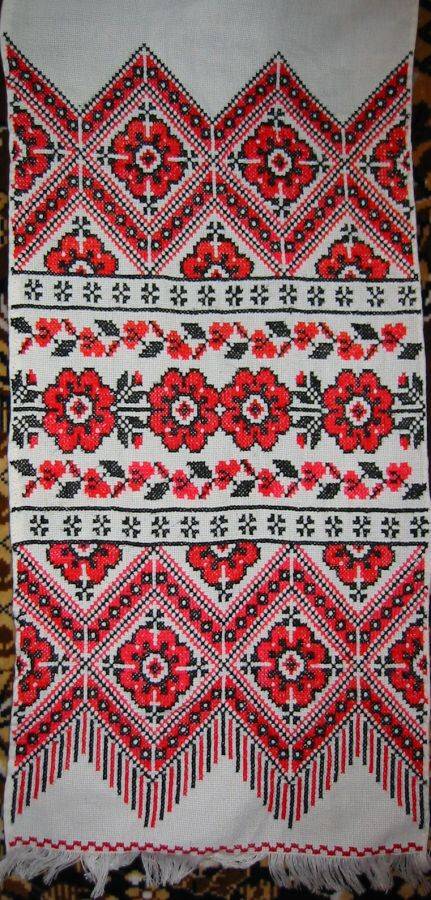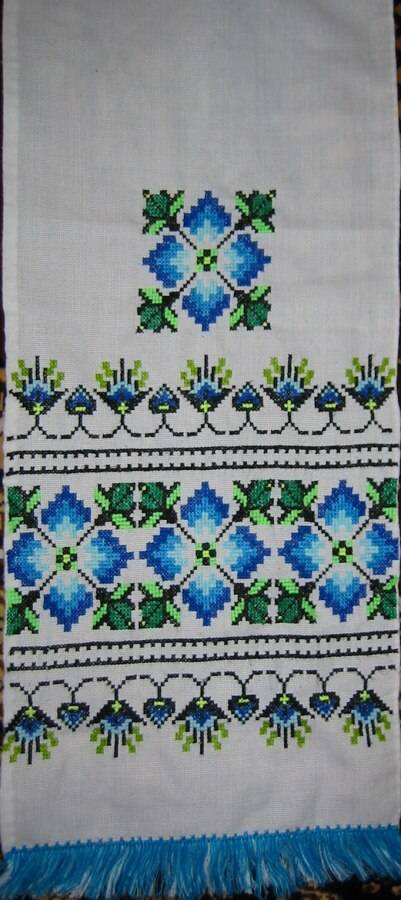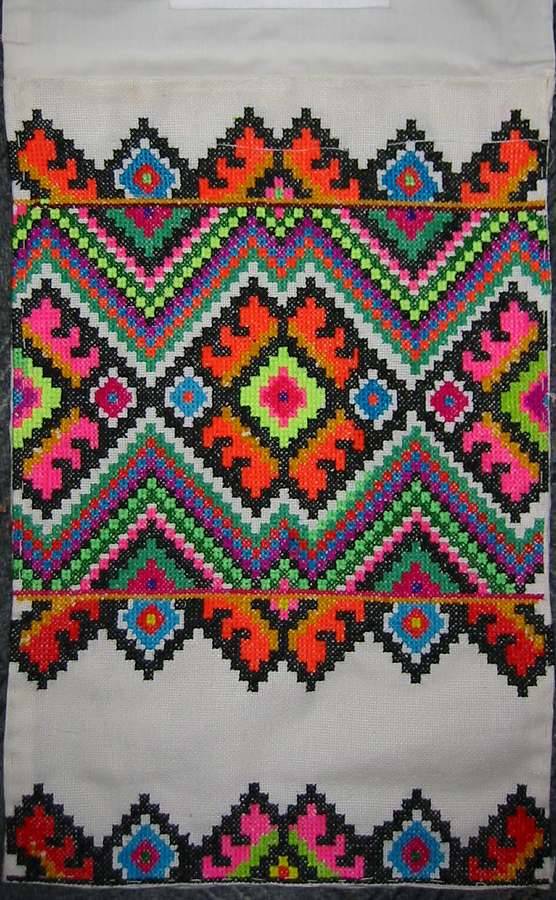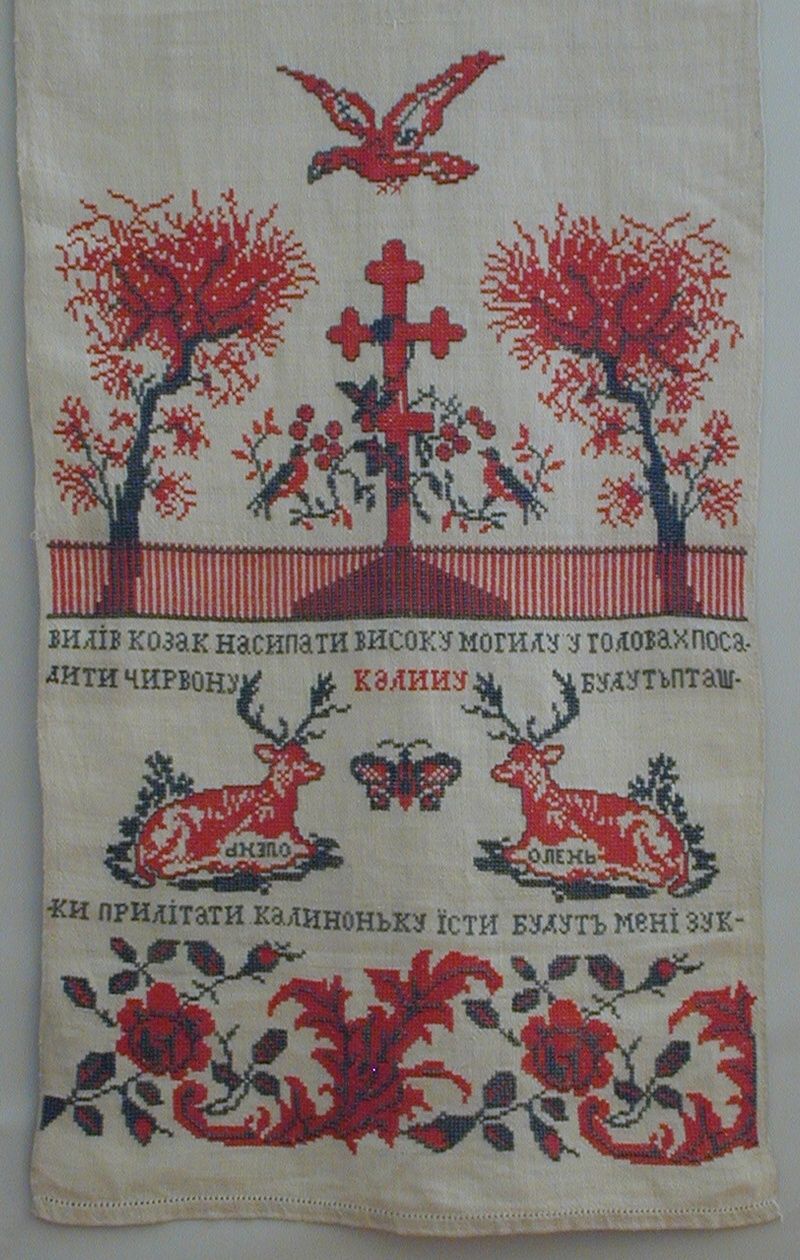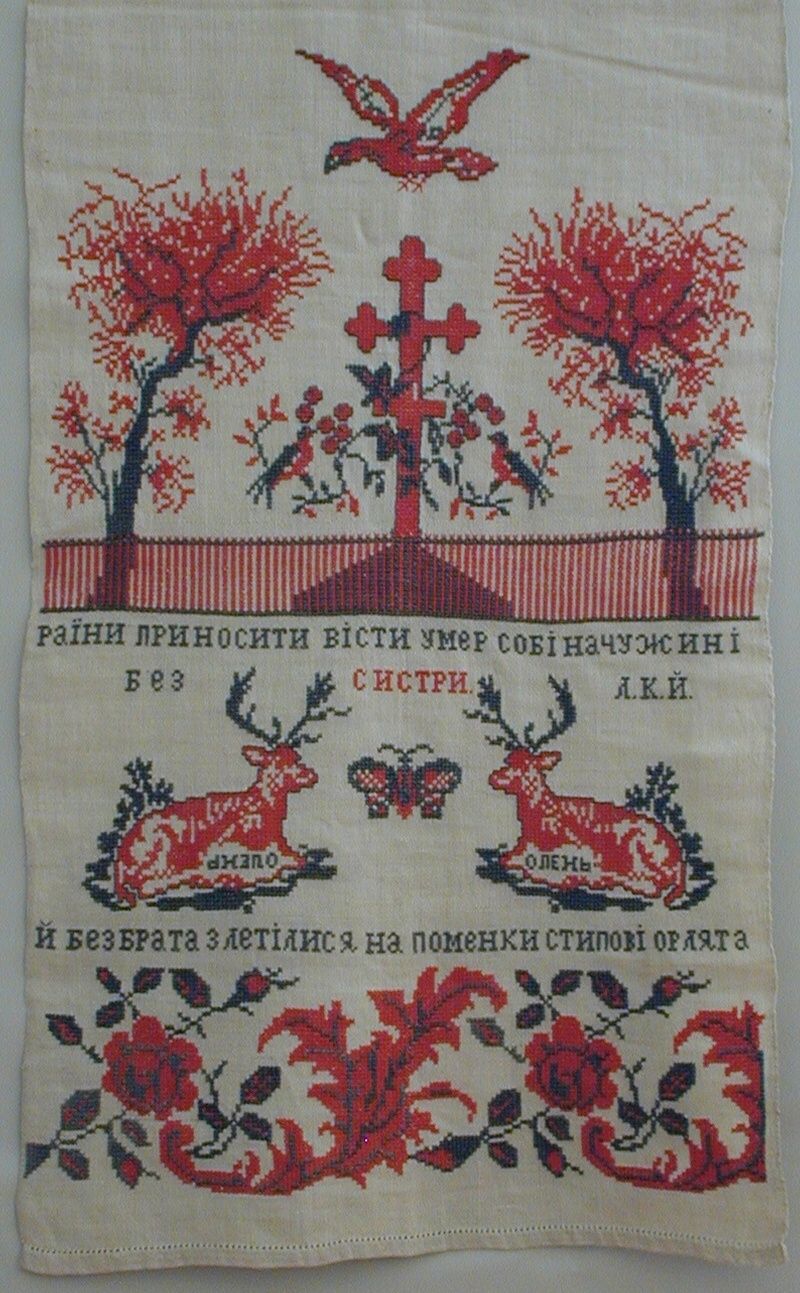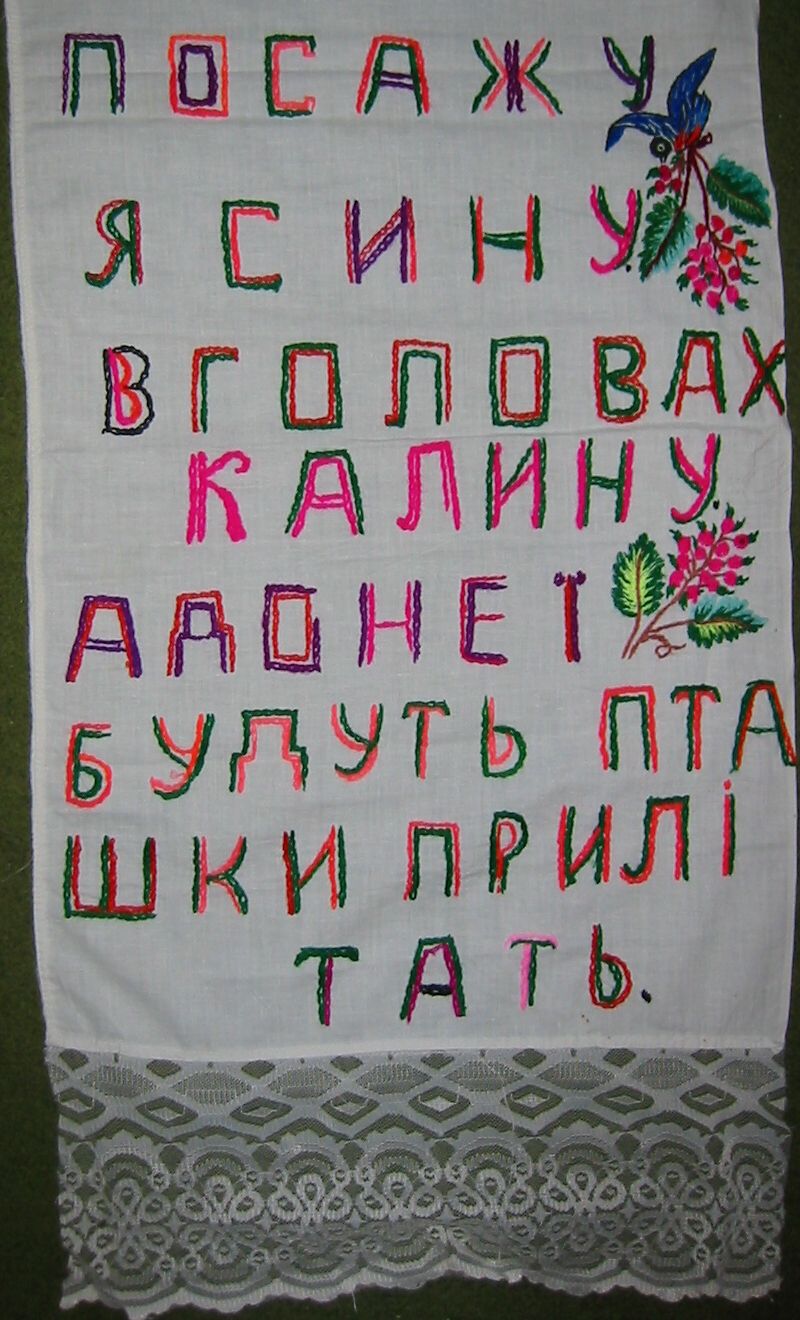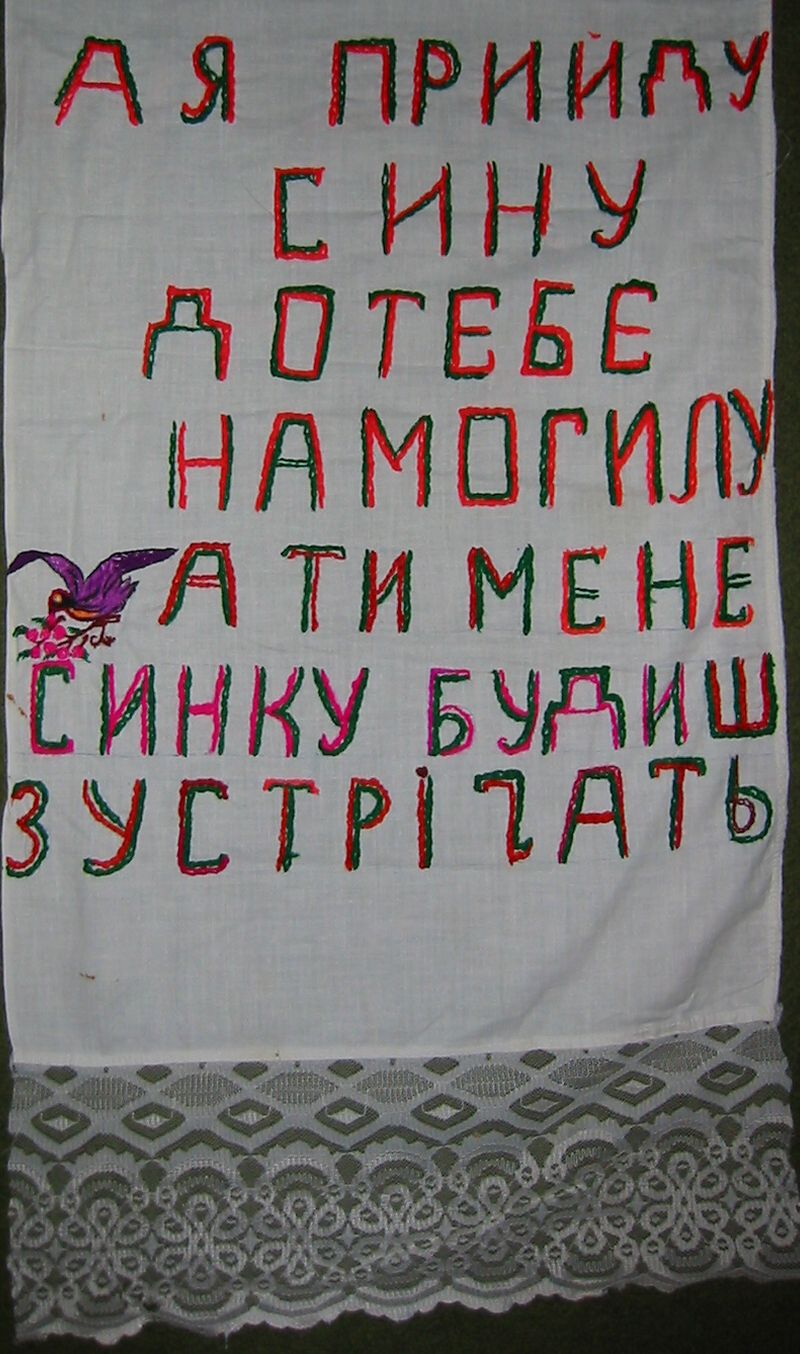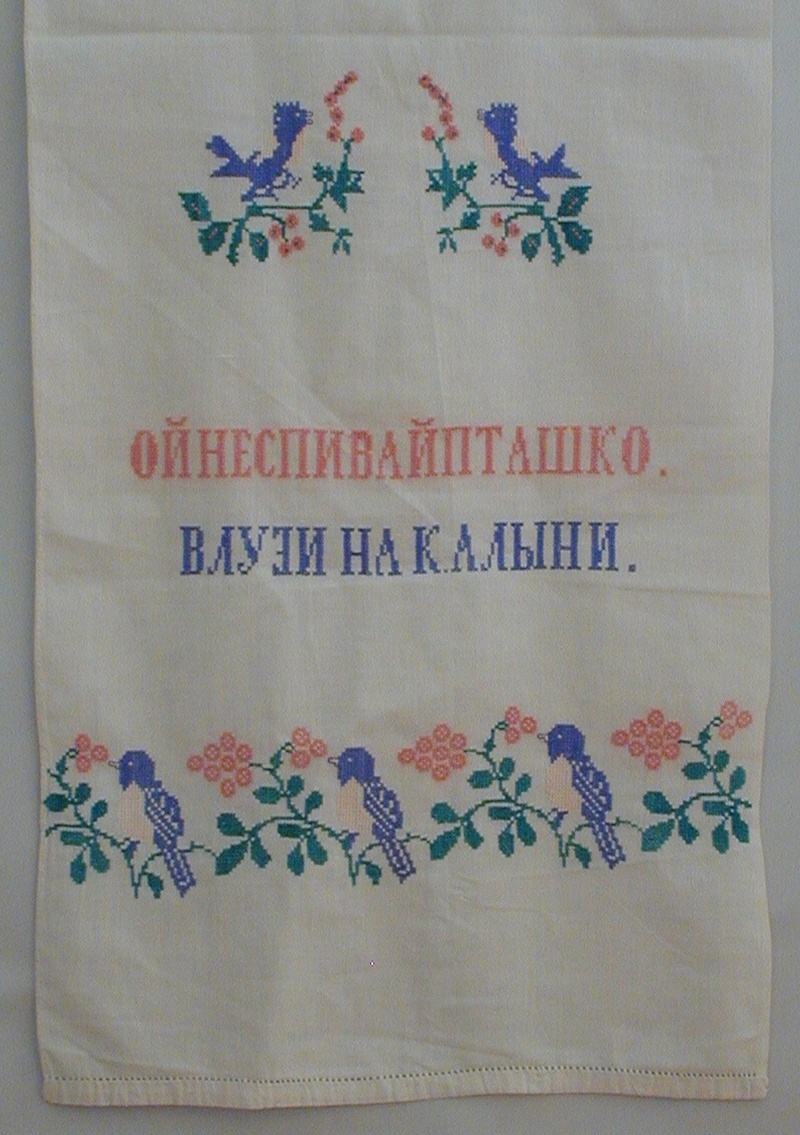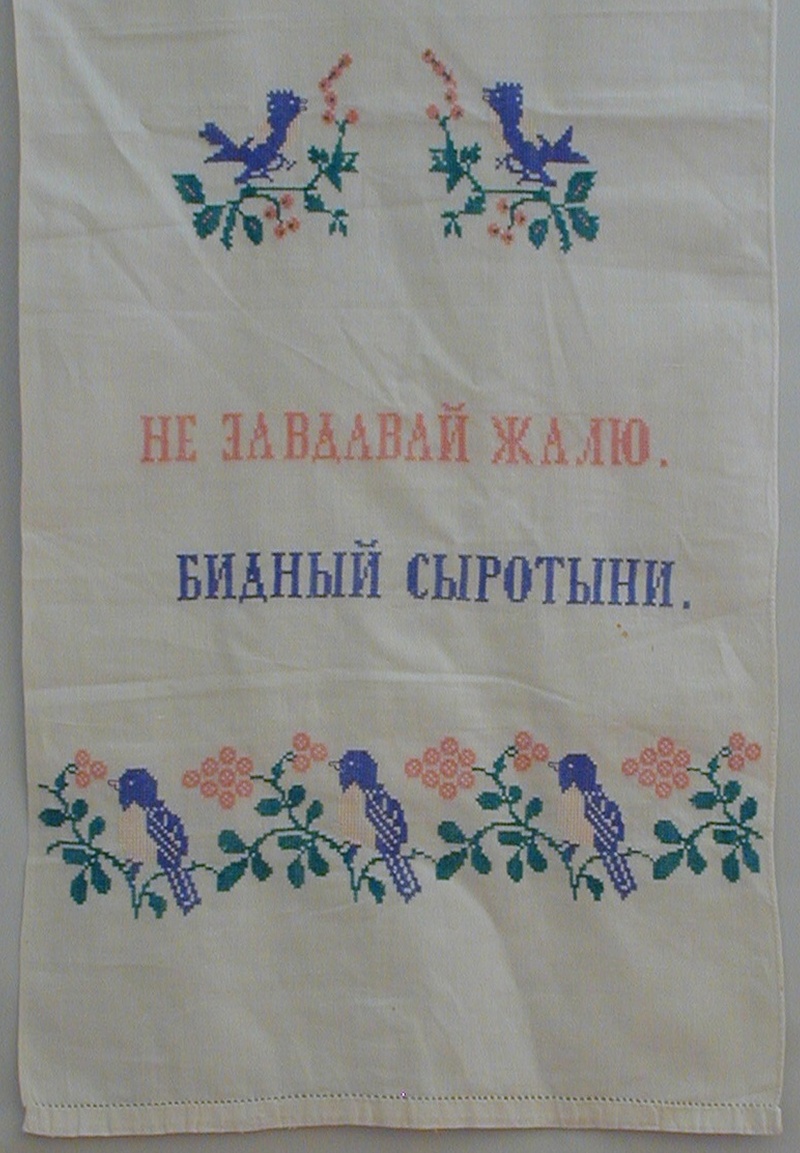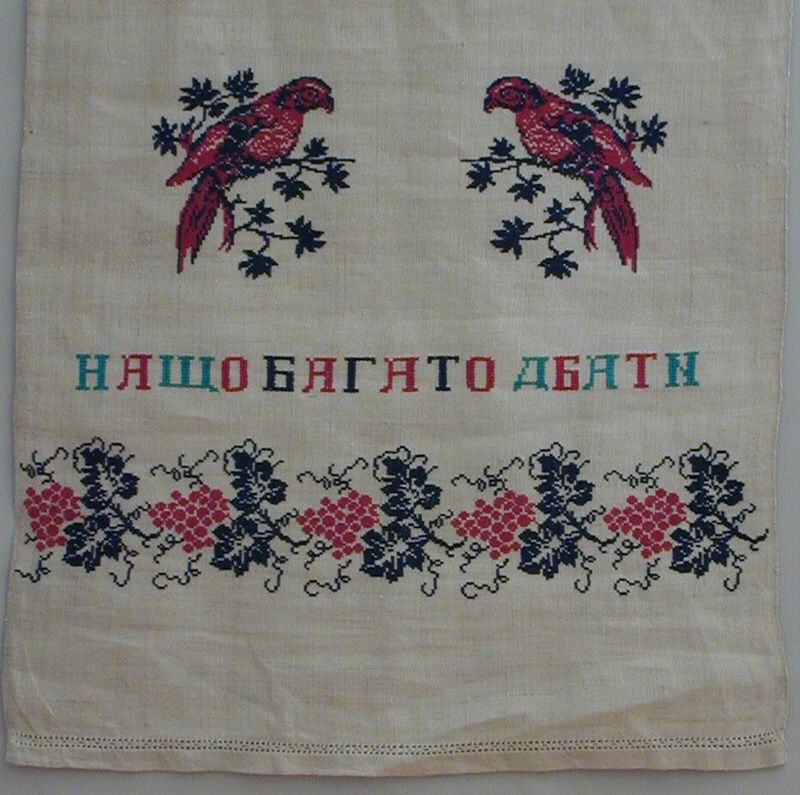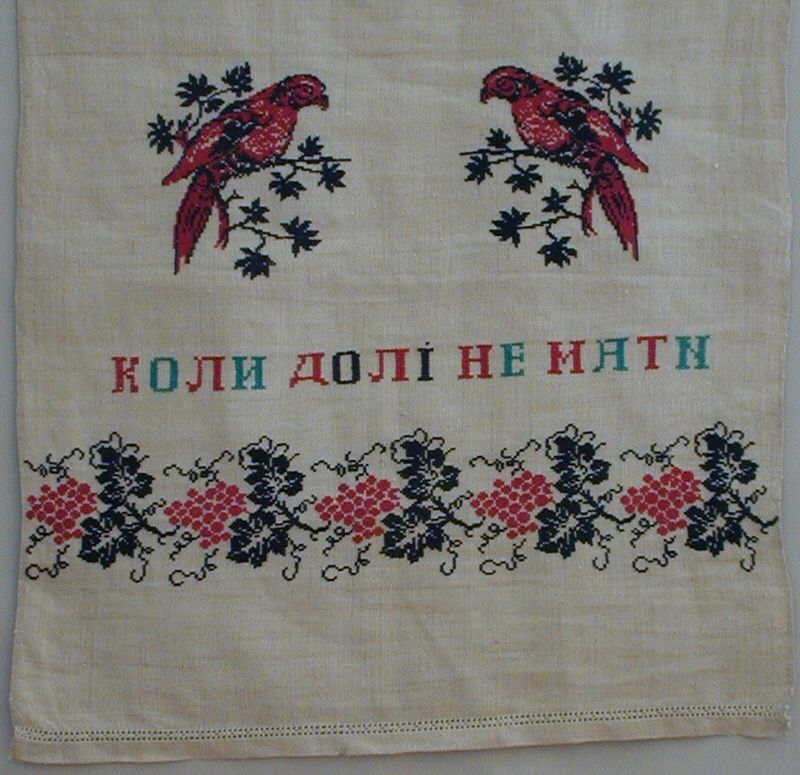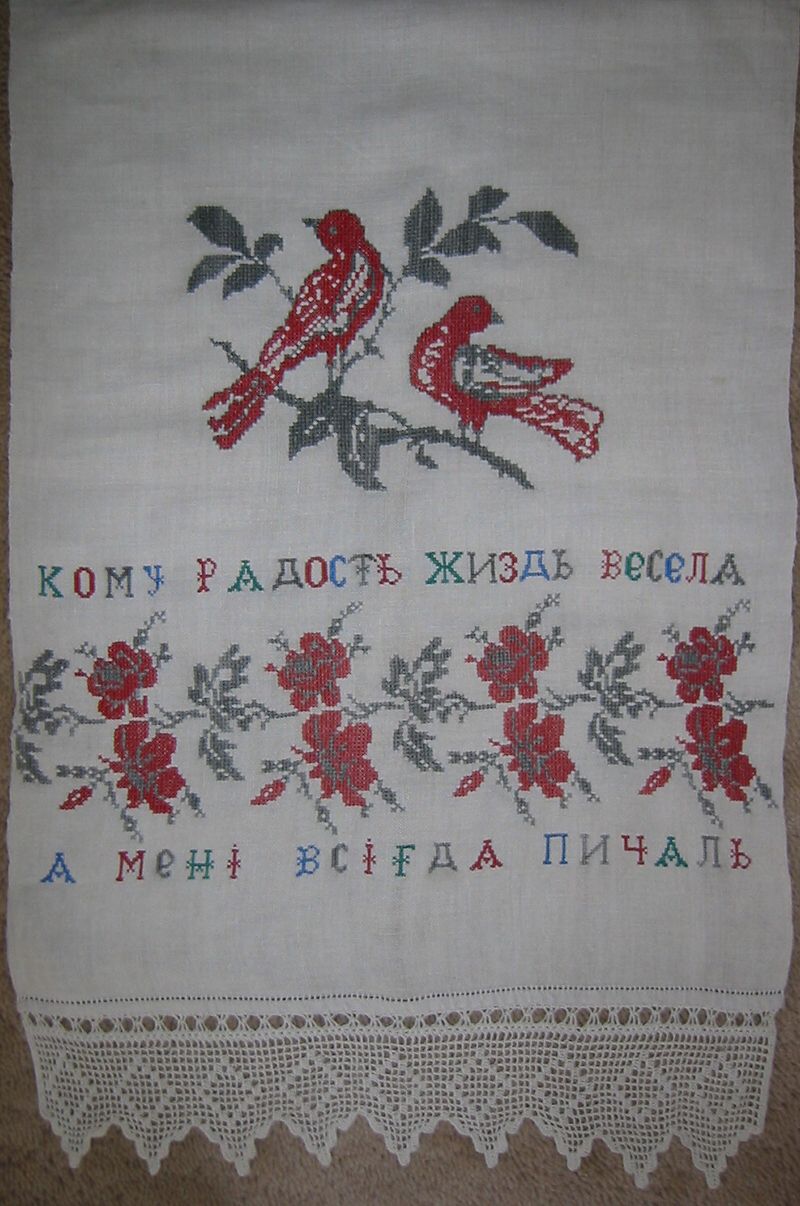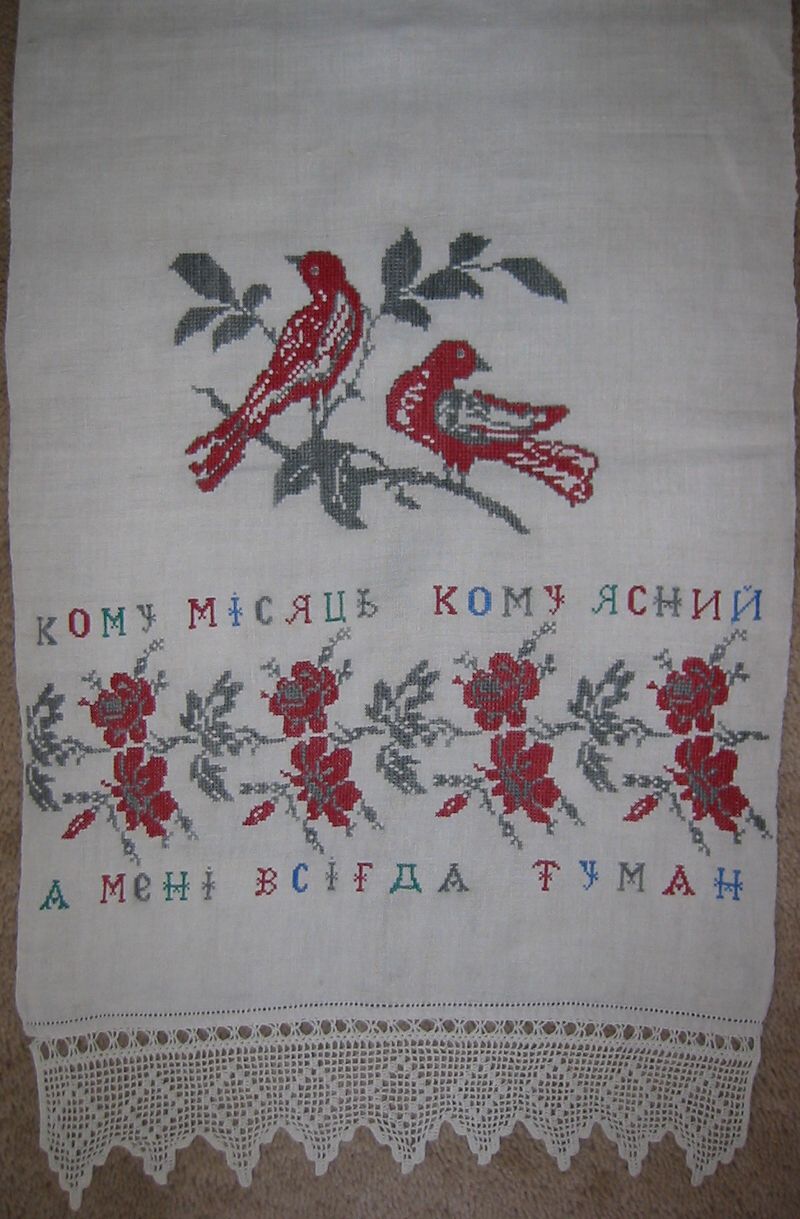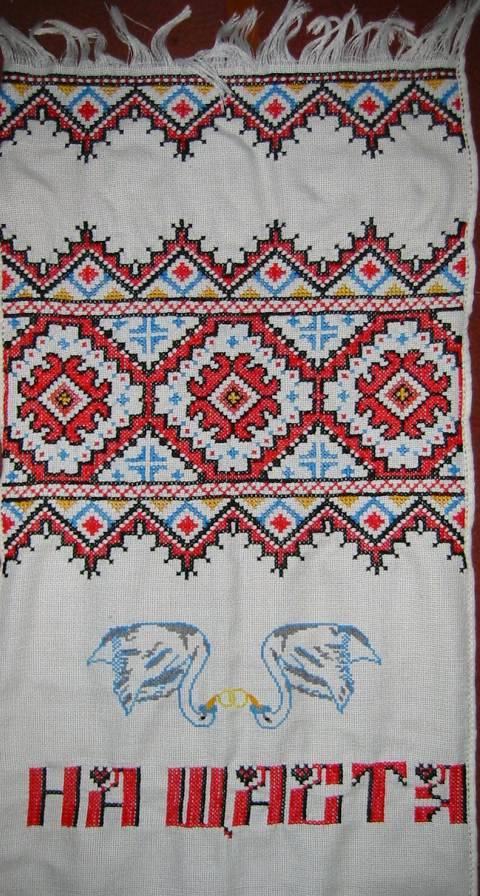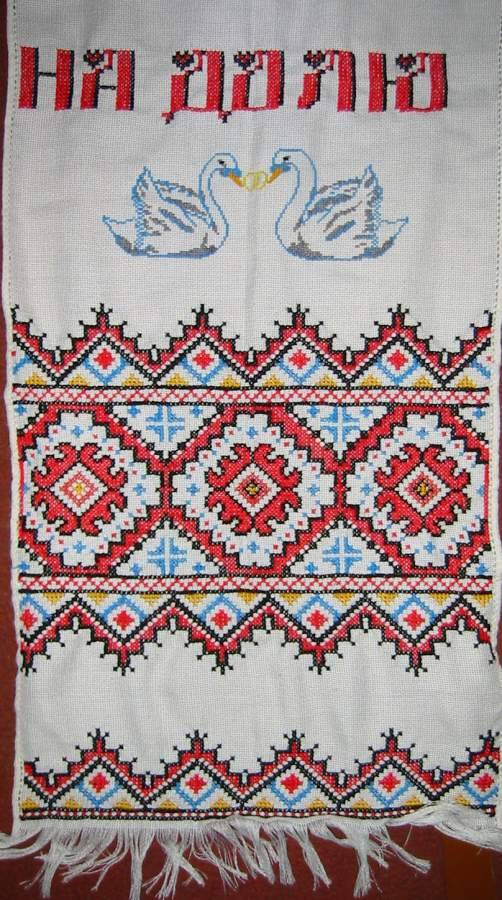Introduction
A rushnyk is a ritual towel. The word comes from ruka, meaning hand, and a regular rushnyk would be simply a towel, a piece of cloth that a person could use to wipe his or her hands. Rushnyk has acquired and is currently used in a double meaning: it retains its simple meaning of “towel” and it has also acquired the meaning of ritual object. The ritual rushnyk is a very important item to which a great deal of power is ascribed. It is used to secure a wedding, to dispatch the deceased to the world of the dead, to protect the home and insure the prosperity and fertility of the inhabitants of the household, among other things.
The origin of the ritual power of the rushnyk is obscure. It may have something to do with the ritual potency of weaving and thus of all cloth. Because the human body is a central symbol in Ukrainian culture, the power of the rushnyk may be connected to the power of cloth to clothe the body. This meaning appears in the begging songs of minstrels and in ritual in the form of the kryzhma, a special cloth given by the godmother and used in baptism. The power of the rushnyk may come from the sacred act of embroidery. Embroidered rushnyky are the most powerful and the most desirable kind. While regular, unadorned towels may be given as gifts to people who help out with weddings and funerals, the rushnyky that hang in the home are all embroidered. In ritual, embroidered rushnyky, or at least printed ones, are the ideal and they are the standard toward which those who can afford it strive.
The pictures below show the role of cloth in all aspects of our existence: the kryzhma at baptism, two pictures of rushnyky in the wedding ceremony, and the rushnyk at the funeral.
——————————————————————————–
Some Examples
In the home, rushnyky must be draped around the icons in the icon corner. Other uses of rushnyky are optional, but extensive. Typically, rushnyky are draped around pictures, be they family photographs or images of important persons such as the poet Taras Shevchenko. The most basic rushnyk to be used in the home is the one with the embroidery motif that is called the tree of life. As its name implies, the tree of life insures the longevity and prosperity of the inhabitants of the household. The tree of life is believed to connect all realms: the underworld, this world, and heaven. Because of this, the tree of life also symbolizes continuity between the past, current, and future generations of a family and between people and the natural world.
Examining the rushnyky made by a single artist gives us a good sense of that person’s aesthetics and it also allows us to see the range that can be found in one person’s creativity. Natalia Petrivna Ponomarenko (born April 10, 1928) is an especially gifted embroiderer, well known in her village of Velykyi Khutir. She likes to embroider flowers and her favorites are roses and pansies, though she executes other flowers with great skill and artistic effectiveness. Her sense of color is exquisite and she has not switched to the acrylic threads and brighter hues that have become popular elsewhere. She works in both satin stitch and cross stitch and claims not to favor one over the other, though, when we visited, we saw more satin stitch items. Her satin stitch peacock is spectacular. It is a picture rather than a ritual towel, meant to be framed and hung on the wall. Her work is much sought-after, but she likes her work so well that she is reluctant to sell. She was convinced to part with a number of her works to pay for her grandson’s cleft palette operation. A rather unusual item is shown in the next two pictures of a text towel. It looks quite different from her other works and does not have the same exquisite sense of color or the same fine stitchery. This towel is not meant for display. Natalia Ponomarenko made it to commemorate the death of her son who died at a young age. She died in ????
We close this section with some other pictures. While these are not rushnyky, they are made by the same people using the same embroidery techniques. The last two rushnyky presented here were collected by Halyna Kapas’ in the area where the Kyiv, Poltava, and Cherkasy regions meet.
——————————————————————————–
Glossary of Rushnyk Symbols
Flowers and vegetation motifs:
Bluebell: fragile beauty, gentleness
Carnation: mature beauty, often used on funeral towels
Cornflower: fertility, fragile beauty
Elderberry blossom: fertility, intoxication, pleasure
Pansy: happiness, often used to represent children
Periwinkle: permanence, eternity, longevity (periwinkle is an evergreen)
Poppy: beauty, love, the intoxication of love
Pumpkin flower: fertility, fecundity, wealth, prosperity
Rose: robust beauty, vigor
Sunflower: fertility, prosperity, abundance
Kalyna: (the rowan tree): longing, healing, often used on towels for soldiers killed in battle and other unquiet dead
Oak: strength, vigor, permanence (the oak is often struck by lightening and is thus associated with the world tree, the tree that connects the underworld, this world, and heaven)
Tree of life: continuity, eternity
Wheat: prosperity, fertility, the strength of the soil
Cherries: fertility, fecundity (cherries are a motif characteritic of the Cherkasy region)
Grapes: fertility, good harvest, growth
Strawberry: fertility, good harvest, growth
Birds, animals, insects:
Cuckoo: sorrow, especially a woman lamenting the death of a family member
Eagle: masculine strength and vigor
Lark: youth, joy, vigor; often used in pairs to represent the young couple
Nightingale: beauty, longing
Peacock: beauty, prosperity
Rooster: vigor, fertility
Swan: beauty, grace, strength
Butterfly: the departure of the soul
Deer: wealth, feminine protection
Abstract motifs:
Band: continuity, eternity
Dispel: this is the term we are using for the many motifs that are at the bottom edges of towels. They are supposed to point down to the ground and take all of the evil out of the household and transfer it into the soil. The earth, it is believed, has the power to absorb evil and disperse it.
Meander: continuity; also associated with water and thus representative of fertility
Rhombus: feminine strength and vigor; birth
Three: totality, unity. The number three is associated with the Christian Trinity and with pre-Christian ideas. Almost any motif can appear in groups of three: flowers, especially roses, bands, trees of life, birds, and so forth.
Wreath-open: wedding; the future of the couple is open and their life is ahead of them
Wreath-closed: funeral; the life of the person is complete and has come full circle
——————————————————————————–
Rushnyky: Tree of Life Symbol
The most basic rushnyk to be used in the home is the one with the embroidery motif that is called the tree of life. As its name implies, the tree of life insures the longevity and prosperity of the inhabitants of the household. The tree of life is believed to connect all realms: the underworld, this world, and heaven.
——————————————————————————–
Rushnyky: Band Symbol
Tree of life motifs can run horizontally instead of vertically and most bands of flowers are essentially horizontal tree of life motifs With the exception of very branchy motifs, most people do not consider the horizontal bands to be trees of life. Rather, they focus on the flowers in the band. What they consider important here is the type of flower selected: each blossom has a meaning, or a set of meanings, that represents a desired quality. For example:
Bluebell: fragile beauty, gentleness
Carnation: mature beauty, often used on funeral towels
Cornflower: fertility, fragile beauty
Elderberry blossom: fertility, intoxication, pleasure
Pansy: happiness, often used to represent children
Periwinkle: permanence, eternity, longevity (periwinkle is an evergreen)
Poppy: beauty, love, the intoxication of love
Pumpkin flower: fertility, fecundity, wealth, prosperity
Rose: robust beauty, vigor
Sunflower: fertility, prosperity, abundance
Kalyna (the rowan tree): longing, healing, often used on towels for soldiers killed in battle and other unquiet dead
——————————————————————————–
Rushnyky: Bouquet Symbol
More modern modifications of the tree of life are bouquets of flowers, especially bouquets in a vase. This is perhaps the most common rushnyk type in the area where the collection was made. Recent innovations include the use of synthetic embroidery threads which produce rushnyky in vibrant colors.
The vase is probably some sort of intermediary between the tree of life and the bouquet and it is not considered a motif in its own right in the glossary below. It may become a separate motif with time.
——————————————————————————–
Wedding Rushnyky
Rushnyky are very important in the wedding and wedding rushnyky are often used as icon drapery in the room where the new couple will live. The wreath is the central motif of the wedding rushnyk and its identifying feature. An open wreath is the motif used to decorate the wedding rushnyk. The open wreath indicates that the couples’ life is ahead of them and that their future is open. The bridal couple must stand on rushnyk when they take their marriage vows and their hands are frequently tied together with a rushnyk. The parents of the groom welcome the new couple into the home with breads held on rushnyky. There are many examples of wedding rushnyky on this site.
——————————————————————————–
Other Examples
Rushnyky are used in other rituals: baptisms and funerals, and for other ritual purposes.
Here are some funeral rushnyky
Traditional embroidery continues throughout Central Ukraine, the one major difference being the use of very bright colors made possible by acrylic threads. In addition to traditional embroidery, several new trends have emerged since independence.
There has been a spread of motifs and designs from Western Ukraine to other territories. Many, if not most, villages have revived their churches. To staff the new or newly reopened churches, the villages needed clergy and most, including Orthodox priests, were trained in Western Ukraine. Ukrainian priests, both Orthodox and Eastern rite Catholic, are allowed to marry. Thus, when a priest came to a village, he brought his family with him. Clergy hold positions of prestige and everything that they and their families do is scrutinized and emulated. Seeing the Western-style embroideries in the homes of the clergy, many villagers in Central Ukraine have begun making rushnyky that resemble the ones found in the home of their priest. This has happened in the village of Ploske. Our hostess, Zina Ivanivna Latysh is making 4 wedding towels, one for each of her grandchildren. She is using Western Ukrainian motifs and colors. Similar towels can be found in the homes of many villagers alongside more traditional designs.
More new trends – the text towel. In the past, towels conveyed their messages in symbols rather than words. Thus pumpkin flowers conveyed wealth and poppies, embroidered on wedding towels, referred to beauty and the intoxication of love. The symbolism of the various rushnyk motifs in listed under the Rushnyk glossary on this website. The various motifs did not need to be labeled because everyone knew the language of rushnyk symbols and could “read” the meaning from the flowers, leaves, berries, and geometric designs alone. Text was just not something that went along with embroidery. Letters are difficult to embroider and text was more appropriate to songs and stories than to rushnyky. There were a few categories of text towels, but these were not to be displayed for all to admire; rather, they were personal expression of loss and pain. Text towels were routinely made for the unquiet dead. People who died violently and before their time were believed to roam the world unless proper measures were taken. Proper measures included the production of special towels. Soldiers who died in battle were routinely commemorated by their sisters who made special towels to insure their repose. Natalia Ponomarenko’s towel for her son falls into this category. Some text towels express other loss: the loneliness of an orphan, the despair of a person for whom all life seems to be going wrong.
In the past, text towels were restricted to expressing loss and easing the pain of sad situations. Today’s innovation is the use of texts on a variety of towels, including those for happy occasions such as weddings. Several factors motivate the use of text. One is loss of meaning. While people could previously “read” towel symbols, the language of symbols is now known by fewer people. The other is the introduction of new motifs whose symbolic meaning is not alien: the motifs and designs from Western Ukraine discussed above. When symbolic meaning becomes obscure, conveying it by different means becomes necessary. Thus, wishes for the happiness and prosperity of a couple about to be married are now often conveyed by embroidering words expressing those sentiments on a rushnyk. Print towels with text were widely used during the Soviet period. Soviet policy was precisely to get away from old beliefs with deep emotional nuanced and to move toward a more rational, more clearly articulated view of the world. Explicit text rather than inarticulate symbolism fit this world view. And, while many aspects of the Soviet system have been rejected with the independence of Ukraine, some practices have remained. Text on ritual towels is one of these.

